Centered fixed width test
Latest update 19 March 2025
|
The format is alphabetical, an A-Z of projects. These are projects coded C to E.
|
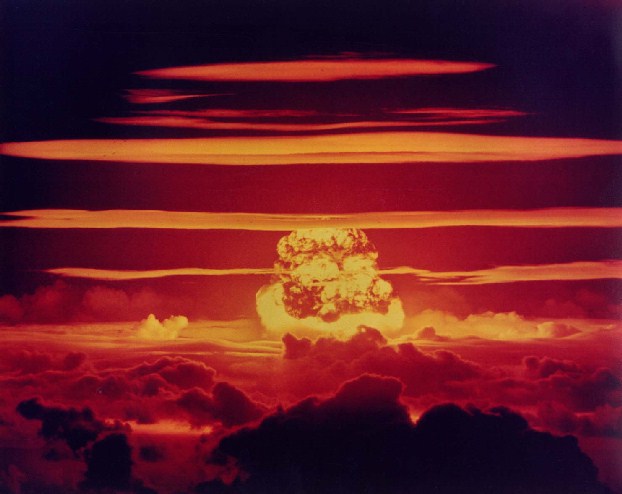
|
Calliope I and IV
Under construction.
|

|
Candle
Under construction.
|

|
CF.299
Under construction.
|

|
Charcoal UGT
Under construction.
|

|
Charlie
Under construction.
|

|
Charybdis
Under construction.
|

|
Chevaline
Under construction.
|

|
Cleo
Under construction.
|

|
Clippeus
Under construction.
|

|
Cob
Under construction.
|

|
Cobalt Bomb
Under construction.
|

|
Colwick
Under construction.
|

|
Composite Core
|

|
Description
Composite core was originally an American term; the equivalent British short-lived description was Mixed Core. Both were used to describe a fissile core that takes the form
of two onion-like concentric spherical shells of two different fissile materials, usually plutonium and U-235. The plutonium shell smaller, innermost, and may be levitated, although not necessarily
so. A composite core takes advantage of plutonium's output of large numbers of energetic neutrons to speed up fission of U-235. An entirely U-235 core will output free neutrons that are less
energetic and so the chain reaction proceeds more slowly, and the final yield from the core is proportionate to the initial speed of the chain
reaction. (1)
The output of faster neutrons from fissioning plutonium permits a greater proportion of the U-235 to be consumed before the fission chain-reaction stops as the core disassembles by expansion
as it blows itself
apart; (2)
and one source claims that yield from U-235 can be increased by this method by up to
50%. (3)
Although there were originally other reasons for adopting a composite core design, the faster speed of the chain reaction made possible by incorporating plutonium is an added benefit for
bomb designers, and has the useful side-effect of resolving a problem with premature detonation facing early fission bomb designers. Another US source asserts that the main purpose of a
composite core was to even out the burn-up flux and produce a correspondingly higher yield; and was originally done to economize on scarce
Pu-239. (4)
Other extensive American sources support that
view. (5)
However, official declassified archives in London, reveal other compelling
reasons. (6)
For any given weight U-235 is a less efficient fissile material than Pu-239. It fissions more slowly than Pu-239. All nuclear cores are self-extinguishing, because as a core fissions it expands
and decreases in density, the chain reaction stops, and the weapon disassembles (blows itself apart). Because neutrons emitted by fissioning U-235 are less energetic than those emitted by
Pu-239, the core reaches the point where it self-extinguishes before it can release as much total energy as an equivalent Pu-239
core.(7)
However, speed of a U-235 chain reaction can be accelerated by the more energetic and plentiful neutrons emitted by fissioning Pu-239. That, reduced to the basics is why a composite
core will fission U-235 faster and more efficiently, and produce a greater yield for a given weight of U-235 than an all-U-235 core could on its own. One official source asserts that in a
composite core, U-235 will produce up to 50% or more yield than an unboosted all-U-235
core.(8)
|
Pre-detonation
Pre-detonation is a British term. An equivalent American term is pre-initiation, and an archaic British description was premature detonation; another archaic variation
used frequently by Sir William Penney was imperfect
detonation. (9) All were used interchangeably to describe the same undesirable nuclear phenomenon known as a " fizzle" caused
by unwanted impurities in
Plutonium-239. (10)
That impurity is the isotope Plutonium-240. Military-grade Pu-239 produced in thermal reactors contains up to 6% of Pu-240; an unwanted isotope from the perspective of bomb designers. It
has undesirable properties in that it can, in close proximity, degrade the physical and mechanical properties of numerous common materials, and it is a hazard to people in close proximity for
extended
periods, (11)
especially submarine crews. It has a rate of spontaneous fission more than 30,000 times higher than
Pu-239 (12)
and causes Pu-239 to fission prematurely, before implosion assembly of the core is complete, resulting in pre-detonation or a
"fizzle", (13)
where a plutonium bomb will fail to produce very little of its full yield; typically only of a few tons yield. A study produced by Sir William Penney of AWRE for the UK Chiefs of Staff found that the
UK projected stock of Blue Danube bombs with a design yield of 30 kt could expect to have up to 18% failures from
pre-detonation. (14)
The Fat Man bomb had a probability of predetonation of 12% (sourced from a declassified Oppenheimer
memo). (15)
Another related now archaic British term of Blended Core was used to describe fissile material that was composed of almost pure (99% or better) Pu-239 that they hoped to produce
in the Dounray Fast Breeder Reactor that could be "blended down" by dilution with Pu-240 contaminated plutonium from thermal reactor production to produce a blend that was of similar or
better quality than weapons-grade
plutonium.(16)
From the earliest times of the Manhattan Project and before DT fusion boosting was understood or available, bomb designers were concerned about the probable rate of pre-detonation in
fission bomb
stocks.(17)
A study at AWRE claimed that up to 18% of all-plutonium cores in Blue Danube weapon stocks of the Hurricane-size yield would "fizzle" (pre-detonate), with a
nuclear yield of perhaps a few tons, rather than the 30 kt full design
yield.(18)
Only by reducing the amount of plutonium in a core could the pre-detonation risk be
reduced.(19)
However reducing core size effectively limited fission bomb yield to 10 kt. With the military customer requiring higher yields than 10 kt, and in the absence of DT fusion boosting technology, early
bomb designers had only three effective choices.
The first possibility was to use a supergrade of plutonium that was almost entirely free from impurities. However this solution was grotesquely expensive, and although used for the Fat Man
bombs exploded at the Trinity test and at Nagasaki, this was a solution that could only be justified by extreme wartime conditions.
A second possibility was to use a composite core of less pure military-grade Pu-239 in a composite weapon. Pu-239 could be reduced in amount while providing a faster kick-start to the
chain reaction that could increase the effectiveness of U-235. That would reduce predetonation risks while producing the higher yields that the military required.
The third possible solution to minimize predetonation risks was to build smaller bombs; limited in yield to 10 kt; a solution adopted as a temporary expedient by the British who until 1957
lacked a supply of U-235 needed for composite
cores.(20)
A fourth possibility, possibly not seriously pursued by the British, was to control pre-detonation risks by using blended plutonium in an unboosted all-plutonium
core.(21)
Little more is known of UK progress in this area. Had it been a successful solution, more would certainly have filtered into the public domain.
|
Composite Core Economics
Composite cores offered a rudimentary but necessary solution to reduce the amount of plutonium used, and hence to reduce the likelihood of pre-detonation.
There were benefits to the military staffs of limiting total plutonium content of a core to approximately two kilograms; the remainder being composed of U-235. A reduced quantity of plutonium in
a core limited the possibilities of pre-detonation, while the benefit of plutonium's higher output of energetic neutrons and faster kick-start to the chain-reaction increased the speed at which
U-235 fissioned. The result was that more of the U-235 fissioned before expansion of the core terminated fission. In short, more of the (cheaper) U-235 was burned than would happen in an
all-U-235 unboosted design. Reduction in the amount of plutonium per core significantly decreased the likelihood of failure by pre-detonation; and improvement in U-235 efficiency made higher
yields than 10kt possible without increasing pre-detonation risks.(22)
Using less fissile material brought an economic benefit by reducing cost per core,(23) while military staffs could use available fissile material released back into the stockpile more efficiently to increase weapon numbers more quickly than was possible with all-plutonium or all-U-235 cores.(24)
However, there is evidence that the economic benefits of using composite cores were a continuing factor in weapons design, even after the advent of boosting had resolved the pre-detonation issue. Evidence has emerged from official sources dated from late 1964 (in production material requirements documents) that discloses the fissile material content of several British copies of US weapon designs and the US W-47. It shows very small quantities of plutonium, and significant amounts of U-235. Of the thermonuclear weapons listed, (Red Snow, Una, W-47) the total quoted amounts of Pu-239 would be split into two components, - a primary trigger and a secondary spark-plug.(25) The total amounts of U-235 may have also been split between two components, - a composite core and a secondary jacket. The reality is that we do not know. However, the amounts of plutonium are so small that it is inconcievable that it alone could constitute the core of a primary, without being a part of a composite core. Red Snow (US W-28 copy) used only 1.6 kg of P-239 split between the core and a spark-plug, while using 11 kg of U-235.(26) The US W-47 used only 2.5 kg of Pu-239 and an astonishing 60 kg of U-235; almost as much U-235 as the 64 kg used by Little Boy. There are other documentary indicators that this practice extended to WE.177 and other US and British weapon designs; and indicates the direction of UK/US weapon design philosophies.
|
In the United States there were Pu-239 stockpile issues immediately after the end of WW2, and composite cores offered a solution to these and brought other strategic bomb stockpile benefits for the United States. In the US there was a shortage of plutonium caused by problems at the three Hanford production reactors, and surplus unused stocks of U-235, and an imbalance between plutonium and U-235 in the supply
chain. (27)
Two Hanford reactors were shut down, one was placed in reserve, and the remaining operational reactor was operated at 80% capacity as a precautionary measure to preserve an essential capacity to produce polonium for initiators. (28)
On the other hand, U-235 production at Oak Ridge was a great success, with production quantities much better than expected. The outcome was a scarcity of plutonium for bomb production, a painfully slow accumulation of strategic bomb stocks, and an overabundance of
U-235. (29)
The Sandstone nuclear test series of 1948 demonstrated that composite cores worked
reliably;(30)
and the Fat Man type bombs in the stockpile were quickly modified to use the Sandstone X-Ray composite core in the improved and relabelled
Mk.3,(31)
and the stockpile began to grow rapidly from 40 bombs in
1948(32)
to a predicted 298 bombs by 1950 year end, and 1650 bombs by
1954.(33)
New and less expensive designs; the Mk 4, the Mk 5, the Mk 6, all using levitated composite cores
appeared,(34)
in appearance similar to Fat Man but much improved, although still only able to be carried by large strategic bombers. The Mk 7
bomb,(35)
in a completely new aerodynamic slimline casing then arrived, was built in large numbers, and unlike all earlier bombs was able to be carried by smaller fighter-bomber aircraft and carried by tactical battlefield missiles Corporal, Honest John and Sergeant. The total numbers built were possible only because composite cores released plutonium earmarked for all-plutonium bombs into the production programme, and the unused surplus output of U-235 was put to use in composite cores.

Sandstone X-Ray test detonation. Photo: Commons.
|
|
Rapidly increasing the build-up of their strategic stockpile was of less significance to the British; because their requirement to stockpile large numbers of weapons was much less than the US. Neither were the British faced with a severe scarcity of plutonium. Their problem was a complete lack of the other fissile material, U-235 until
1956. (36)
The UK Chiefs of Staff adopted a policy to limit design yield of Blue Danube to 10 kt, because at that time, the UK had no supply of U-235
available,(37)
and Blue Danube Mk.1 cores were an all-plutonium design. The military judgement of the UK Chiefs of Staff was that the available supply of fissile material (whatever that was composed of) should be eked out by using as little as possible in each bomb core. From that judgement followed their decision to limit Blue Danube cores to
10 kt.(38)
That was intended to mitigate risk from Pu-239 impurities and predetonation until U-235 from UK sources became available in 1956, when new production could be of composite cores, containing less plutonium, or going for higher yields; and recent research shows that did happen with an improved version of Blue Danube yielding
16 kt.(39)
Declassified archives disclose an "Improved Mk.1 Bomb", and this almost certainly refers to Blue Danube Mk.2, which was known to exist; although precise detailed information is very
sparse.(40)
Blue Danube Mk.2 was likely to be a weapon with an updated composite core. There is documentary evidence that the Chiefs of Staff planned to transfer existing Blue Danube cores to Red Beard when that weapon became available. However, there is no evidence that there was ever a version of Red Beard with a 10 kt yield. The only known evidence of actual yield of deployed bombs (as distinct from various plans and wish-lists) is of a 15 kt yield.(41) So for core transfers to take place, these could only be cores that could yield 15 kt in Red Beard's smaller implosion sphere, and were at low risk of predetonation. Ergo: composite cores yielding 15 kt in Red Beard or 16 kt in the larger, higher compression Blue Danube implosion sphere. Logic dictates that these cores transferred from Blue Danube were composite cores, and that Blue Danube Mk.2 used a composite core yielding
16 kt.(42)
slightly greater than when used in Red Beard because of Blue Danube's greater implosion compression.
When U-235 began to be available in the UK a composite core design solution for the higher yield required for Red Beard became
possible.(43)
It is not known precisely what the plutonium and U-235 content of the Blue Danube and Red Beard tactical kiloton bombs
was.(44) However, Red Beard was not a boosted bomb, and the only possible method available at that time to contain predetonation risk to acceptable levels at yields greater than 10 kt was a composite core. Logic dictates that a composite core solution was adopted for Red Beard to produce the well-documented higher yield of
15 kt.(45) By 1958 in the final Grapple test, Burgee, the British demonstrated that they had understood and mastered D/T fusion gas-boosting
technology,(46) and initiation of fission using External Neutron Initiators (ENI). Both of these were better techniques for reducing plutonium content, and dealing with the issue of unwanted Pu-240 and pre-detonation; and created the possibility of making an immune bomb, less vulnerable to countermeasures and plutonium poisoning. Reduction of total quantity of Pu-239 per weapon was also a desirable requirement for achievement of one-point-safety.
However, even with D/T boosted bombs, composite cores still offered advantages in cost reduction, since U-235 was considerably less expensive to produce than plutonium. In the early 1950s UK production of Pu-239 was of the order of cost to the Armed Services of £135,000 per kg, while U-235 was priced at
£21,000;(47) a ratio of 6:1 and a very substantial encouragement to adopt composite core designs. When U-235 became available to the UK, their existing stock of plutonium could theoretically be stretched by this technique to build five bombs for the equivalent of one all-plutonium weapon.
|
D/T Fusion Boosting
Before the UK thermonuclear programme began in the early part of the 1950s, the military planning staffs began to plan for considerable numbers of unboosted fission weapons of various types and yields making use of composite cores.
The discovery of Tritium/Deuterium fusion-boosting, that a fission chain-reaction could be given a hefty kick-start by introducing D/T gas into a sealed core where implosion compression would initiate a small-scale fusion reaction and flood the fissile core with copious quantities of 14 MeV neutrons of much greater energy than could be produced by fissioning plutonium, brought an understanding that poorer quality plutonium could be used if necessary; that the composite core technique of increasing the efficiency of U-235 was no longer necessary for that purpose, and D/T fusion boosting would control Pu-240 spontaneous fission in all cores; whether composite ones or all-plutonium cores. However composite cores were still desirable for the economic benefits they offered. Even with this newer technology, it was still a desirable design objective to reduce expensive plutonium to an absolute minimum while augmenting yield by inclusion of cheaper-to-produce U-235, available in UK stockpiles from 1956.
|
China, France, Russia, others, and aspirant states
China is known to have conducted at least two atmospheric tests of composite core bombs; their twelfth and thirteenth
tests. (48) The Chinese began their nuclear weapon programme with supplies only of U-235 and all their tests of fission devices until 1968 used U-235 cores. The first plutonium production reactor at Jiuquan did not begin to operate until December
1966; (49) and the first test of a plutonium cored device was their eighth test and held in 1968. (50)
Little is known of the French and Russian experiments with composite cores or their timing. However, the topic here is composite cores, how they work, what were the advantages and disadvantages. This is not a competition to score points about who got there first, second or third. Except to finish by saying that the many secrets the atom spy Klaus Fuchs passed to the
Soviet Union included those of composite cores.(51) Without that knowledge, the Russians may well have struggled to accumulate large numbers of bombs, as the Americans had struggled before them.
The French nuclear programme may have had no significant problems with predetonation, and no need to use composite cores except possibly for economic reasons. Their two original
thermal reactors G1 and G2 used for military-grade plutonium production are worn out and now shut down. They had also invested heavily in building fast breeder reactors. Their first prototype
fast breeder was Phénix, and its successor Super Phénix is now also shut down. Fast breeders produce as a waste product better quality plutonium of high purity that can be
better than 98% pure, and almost free of Pu-240. Although evidence is sparse, there is some that suggests that fast breeder production was intended for the French military
programme.(52)
Possibly on it's own, or blended down with less pure plutonium produced in thermal reactors. Although the point is of only academic interest now since the French fast breeder programme
ended with the closure of Super Phénix in 1997. A British Foreign Office
paper(53)
claimed that air-sample monitoring of French atmospheric thermonuclear tests disclosed that the first French thermonuclear test device used 'cheap' civil-grade plutonium for the thermonuclear
'sparkplug', where predetonation is also potentially an issue. In the classic Teller-Ulam thermonuclear design, the sparkplug is a rod of fissile material inside the cylindrical fusion fuel that
fissions when irradiated by the primary (fission trigger) to generate the heat and pressure required for the fusion reaction to start. Hence the label of sparkplug.(54)
The UK Foreign Ministry paper noted that all known British, American and Soviet thermonuclear weapons used a U-235
sparkplug,(55)
and asserted that the French technique, if it became more widely known (other than by the US and the UK who were able to collect atmospheric samples), that the use of civil-grade plutonium
could open up a quick, cheap route to thermonuclear weapons, and acquired by non-nuclear weapons states that had supplies of civil-grade plutonium derived from their nuclear power assets,
and that would be a great concern to the Foreign Office. West Germany was a special concern, with the likely consequences for relations with East Germany and the USSR if the West
Germans were seen to be aware of the French development and the possibilities it offered. The East Germans were known to have a close interest in West German nuclear capabilities, and the
Foreign Office paper noted that there had been an academic paper on the topic of civil-grade plutonium and the possibilities for West German development of nuclear weapons published
recently in East
Germany.(56)
As an operator of nuclear missile submarines, the French would have, like the US and British, a requirement for high-purity plutonium in SLBM warheads that does not present a health hazard
to submarine crews as Pu-240 is known to do.
There is little evidence of use of composite cores by newer and aspirant nuclear states. In the 1940-1960 period, composite cores offered the three original nuclear states of the US, USSR and
the UK, a solution to the twin issues of predetonation and fissile material scarcity. The predetonation issue was more effectively dealt with by using DT boosting when it became available,
and later, possibly by means of laser enrichment of Pu-239. Thus rendering composite cores unnecessary to resolve their detetonation issue. If one supposes that DT boosting is within the
reach of newer and aspirant nuclear states, and that the technology of DT boosting is now well-understood, and aspirant states have easy access to the world's published scientific knowledge,
then they have no need of composite cores to resolve predetonation issues. Aspirant states have the further advantage that they know that DT boosting is a viable and doable technology;
unlike the original nuclear states; who did not know with certainty that the technology was achievable. The aspirant states can jump the composite core stage in nuclear weapons development
and go straight to the DT fusion boosting stage. That leaves only a question about fissile material availabilty. Again, the original states were working on the very edges of known science; feeling
their way forward into the unknown. Not knowing the extent of the unknown, to borrow a Rumsfeldian phrase. With the benefit of published scientific accounts and the history books, aspirant
states will have a much clearer understanding of the ratio of different fissile materials they will need, and to plan infrastructure to produce it in the required ratios when they take a decision to
embark on a nuclear project. They may choose to use composite cores for their economic benefits for either boosted or unboosted fission weapons. Or choose to produce only thermonuclear
weapons where composite cores are probably less useful given the small fission trigger sizes required if they are DT fusion boosted.
|
List of Early US Weapons with Composite Cores
USA (57)
(58)
Mk 3 60 inch diameter strategic bomb. Improved Fat Man.
Mk 4 60 inch diameter strategic bomb. Improved Fat Man.
Mk 5 44 inch diameter strategic bomb.
Mk 6 60 inch diameter strategic bomb.
Mk 7 30 inch diameter tactical bomb for external carriage on fighter-bombers.
Widely deployed with NATO allies in Europe.
W-7 30 inch diameter warhead used with Corporal and Honest John SSMs.
Deployed with the US Army, the British & Canadian Armies in Europe, and NATO allies.
W-28 Thermonuclear bomb and warhead built in large numbers in service until c1990.
W-34 Boosted Python primary for W-28 thermonuclear bomb and warhead.
Boosted Python warhead used in the Mk-101 Lulu NDB and Mk-105 Hotpoint bomb.
W-44 Boosted Tsetse primary for several thermonuclear weapons, and built in large numbers.
W-47 Boosted Robin primary for W-47 thermonuclear warheads in Polaris A1 & A2 SLBM.
W-54 Unboosted warhead used in several weapons, including the Davy Crockett spigot mortar.
Mk-101 Lulu NDB deployed with the US Navy and several NATO allied maritime air forces.
Mk-105 Hotpoint Laydown bomb deployed with the US Navy.
Row 1: Mk.3/4 Mk.4 Mk.5 Mk.5 Mk.5 Mk.5 Mk.5 Mk.6 Mk.6.
Row 2: Mk.6 Mk.6 Mk.7 Mk.7 Mk.7 Mk.7 Mk.7 Mk.7 Mk.7.
Row 3: Mk.7 Mk.7 Mk.7 Mk.7 Mk.7 Mk.15 Mk.15 Mk.15 Mk.15.
Row
4: Mk.15 Mk.15 Mk.15 Mk.15 W-7 W-7 W-54 W-54 W-54
|

|

|

|

|

|

|

|

|

|

|

|

|

|

|

|

|

|

|

|

|

|

|

|

|

|

|

|
|
References
- Dr Richard Moore. The Real Meaning of the Words: a Pedantic Glossary of British Nuclear Weapons.
- Yogi Shan. Death's Twilight Kingdom. The Secret World of US Nuclear Weapon "Design Data". Especially Part B,
The Early (1945 - 1962) US Nuclear Tests.
The lack of page numbers and an index prevents using this book more extensively as a reference source, good though it is. ISBN 978 151 1674829
- Norris, Burrows, Nuclear Weapons Databook Vol V, British, French and Chinese Nuclear Weapons. p 82-83.
& Fieldhouse Pub: NRDC 1994. ISBN: 081331612X
|
Conifer
Under construction.
|

|
Cormorant UGT
Under construction.
|

|
Corporal SSM
Under construction.
|

|
|
Description
Corporal was the first American missile system to be equipped to deliver a nuclear warhead, (1) and the first operational guided missile of the U.S. Army. (2) It evolved from a series of Army research rockets begun in 1944-45, and when deployed was roughly equivalent to the Russian Scud A SSM (R-11) in range, size, weight, fuel, oxidizer, warhead, and tactical employment. The Soviet missile however differed in one important respect in being deployed on board a dedicated transporter, erector, launcher (TEL) giving it better tactical mobility; and the Soviet Scud systems were subsequently developed further, giving them a substantially longer operational life.
|
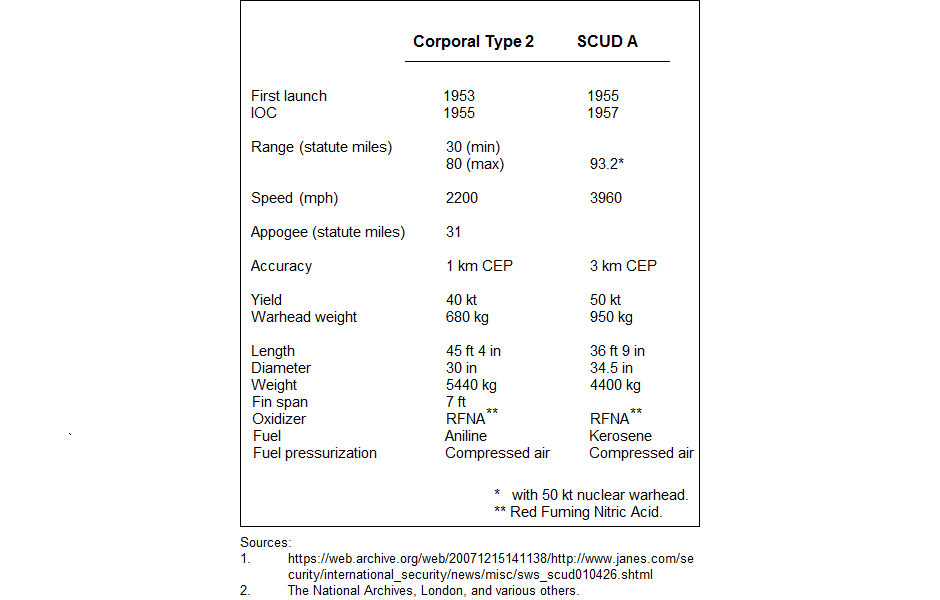
Corporal was the first surface-to-surface guided weapon to enter service with the US Army and the British Army. The two armies had no previous experience of operating SSMs, no established logistical or maintenance procedures, and no established tactical doctrine to fall back on. So Corporal was very much a learning exercise; a means of developing tactical doctrine for Corporal and successor missiles. As a first-generation attempt at an operational SSM, it's much criticised introduction into operational service should be viewed in that light, - as a first step learning exercise. (3)
The immediate forerunner of the tactical Corporal SSM was the RTV-G-2 Corporal E surface-to-surface test vehicle. It was first flown in May 1947. (4) Corporal E was used to evaluate basic principles of ballistic guided missile construction, flight, and guidance. Problems with the US Army's SSM-G-9 Hermes (5) programme led to a decision in 1950 (6) to develop Corporal E into a tactical nuclear-armed ballistic missile, designated SSM-G-17 Corporal. In 1951, the US Army missile designation system changed slightly, and the RTV-G-2 and SSM-G-17 became RV-A-2 and SSM-A-17, respectively. There were other missile systems under development and competing with Corporal, notably the Hermes A-3, based upon development by the General Electric Company and Redstone Arsenal of the German V2. This was considered as a possible contender for the British Army purchase, but was quickly rejected, and the British opted for a system common to the US Army. Unlike Hermes, Corporal was all-American in origin. (7)
Main contractor for Corporal was the Jet Propulsion Laboratory (JPL), and the early Corporal missile airframes were built by Douglas. However, the contract for the production of the operational missiles went to Firestone in 1951, after missile design had been frozen. The first tactical SSM-A-17 Corporal version was also known as Corporal Type I. The first flight occurred in August 1952, and in April 1954 US Army units began training with the missile, designated Guided Missile XM2 in service.
|
|
Military rationale
Much has been written about tactical nuclear weapons, about their technical and military characteristics, their design and engineering development history, and the ethical, moral and political consequences of their use, or threatened use. Yet almost nothing has been written about why armies believed they were a useful addition to their armouries. Or why armies believed that they were a better choice than the alternatives. To understand the military viewpoint it is first necessary to understand how armies got to that position, and to understand the development and history of 20th century high-intensity conflict.
All armies base their strategy and tactics on past successes and past failures. Some failures can be traumatic and lead to radical solutions. One such traumatic experience was the arrival on WW1 battlefields of the machine-gun, the associated stagnant trench warfare, and the bloody consequences of attempting to move infantry forward on that battlefield dominated by machine-gun and artillery. Western allied armies introduced the tank in an effort to break the stalemate. They then discovered after the early tactical mistakes of piecemeal use, that tanks alone, even if more developed and reliable than in WW1, were insufficient.
A more successful solution came by 1918 with integrated arms of infantry, tanks and artillery. The artillery arm, later supplemented by ground attack aircraft (really only another form of heavy weapon delivery with longer reach) moved on and developed with mobile armoured forces by the German Army into the blitzkrieg technique, and in that form was copied, adopted and successfully deployed by the western allied armies and the Red Army. Those techniques of massed formations of artillery, ground-attack aircraft, armour and motorized infantry, allied to adequate motorized logistics, permitted armies to move forward on the battlefield, and the result was mobile warfare, and was the key to the defeat of the Axis European powers in 1945.
Post-1945 there was a perceived need by armies for longer-ranged artillery. Super-heavy guns had been found inefficient and unwieldy on a fast-moving battlefield. They offered longer range but at a price in immobility, and in mobile warfare were not a practical solution. Only in siege warfare were the disadvantages of super-calibre guns of no consequence. In mobile warfare, longer range could be met in part by ground-attack aircraft. Air support certainly met criteria for mobile warfare; but air support was less effective at night, was weather-dependent, and had the further disadvantage that ground-attack aircraft were not under the direct command of army field commanders. Inter-service command structures, although much improved by 1945, were fragmented and hampered by poor communications; and bad (no-fly) weather left ground forces vulnerable, as the American armies found at the Battle of the Bulge. Army field commanders yearned for an all-weather, all-conditions, always ready-to-use weapon that was under their own direct control. As conventional field artillery is, and conventional air-support was not.
Many predictions of a westwards surprise offensive showed that Red Army tactical air forces would have an overwhelming advantage, denying western allied air forces the air superiority they needed to support western ground forces. (8)(9) War gaming showed that army field commanders were likely to be on their own, with no air support, and with air support grounded by poor weather rather than enemy action, always a possibility in north-west Europe, and commanders left with only those weapons under their direct command. Weapons like conventional tube artillery, that once launched were invulnerable to countermeasures, and could not be shot down.
Then in late 1945 came the unexpected game-changer.
When the Soviets managed to deploy tactical nuclear weapons in numbers, whether delivered by ground attack aircraft or short-range tactical missiles, never again could large formations of artillery and armour be massed on the battlefield; for these large formations were themselves worthwhile atomic targets. A single aircraft delivering a single atomic weapon could take out a large proportion of an army's artillery, or a whole division of tanks; and also neutralise those large, impossible-to-hide, and vulnerable airfields that ground-attack aircraft and air-superiority fighters were utterly dependent on.
The new atomic boy on the block had made smallness
and mobility the keys to survival on the battlefield.
|
One of the most powerful weapons in the hands of a commander in the field is the artillery concentration. The system which was highly perfected during the last war had great speed and flexibility but the extent to which it can be developed is limited by the range of the gun.
In the type of operations which we may expect in any future war we shall be fighting on wide frontages and in the early stages operating under conditions of air inferiority. The number of regiments which could be brought to bear on one target would be many fewer than the number which produced the effective concentrations which we used in the last war. While there is, therefore, an urgent need for greater range for field artillery, in fact only marginal increases are likely to be achieved from conventional guns. The requirement cannot be met by heavy artillery since it would be quite uneconomical on manpower and transport to provide the numbers of heavy regiments required. Further, very long -range guns are unsuitable for producing artillery concentrations.
The requirement is for a surface-to-surface guided missile with a range of 75 miles, which could carry an atomic warhead and place it with accuracy upon a designated target. The rapid destruction of such targets, e.g., major troop-marshalling areas or communications centres cannot be achieved by conventional artillery with limited range and effectiveness, whilst the use of aircraft is subject to weather conditions and to the possession of local air superiority.
If the Russians use their conventional tactics for a mass attack they will concentrate an irresistible force to make a breakthrough on a narrow front. Such a force will be on a much greater scale than anything we can muster and the differences in British armaments, tactics and training may be insufficient to counterbalance their numbers. On the other hand this attack may fail in confusion if it does not go rigidly to plan. An atomic/CW weapon is the best means of upsetting their attack but, since they will undoubtedly achieve air superiority, delivery by our air forces
will be impossible.
Corporal offers a sure way of delivering an atomic/CW projectile. There should be no great difficulty in locating a target of this nature with sufficient accuracy for the weapon to be effective. Assuming that the best range for Corporal is about 60 miles, then if the launcher were centrally placed 25 miles behind the forward lines they could cover a frontage of about 100 miles.
Extract from a paper prepared for the UK Army Council. Author: an unknown staff officer. Circa 1953.
Source: TNA, London. WO 32/21235 e6 p2 and e13a p1.
Leaving no doubt how high-intensity fighting was expected to unfold on the modern battlefield, there is this quote from a British War Office pamphlet issued to officers at all levels, designed to stimulate study and fresh ideas. (10)
Nuclear artillery will become the predominant arm on the nuclear battlefield,
with armour and infantry in support of it.
Without doubt, Plan A was to fight a tactical nuclear ground war to resist the Red Army. The battleground was to be Germany. Whether that nuclear ground war was likely to be the trigger for global strategic nuclear war is not within the scope of this article, and readers are left to reach their own conclusions.
From its birth, NATO relied on the doctrine of first use of [ tactical ] nuclear weapons,regardless of whether such instruments were used against it.
(12)
The weapon of choice in the late 1940s both in the US and the USSR was the short-range ballistic rocket. Basically, developed copies of the German V2 or similar missiles of American origin, (13) with shorter range than the V2 of approximately 80 miles. Being reasonably mobile, these rockets out-ranged the longest-range medium and heavy artillery. Equipped with nuclear warheads, just a few missile battalions fielding 2-4 launchers each deployed 20-30 miles behind the front-line, with adequate missiles in reserve, were sufficient to cover the entire front of a complete army group of perhaps one hundred miles. (14) Shorter range Honest John unguided missiles and 280mm guns, (15) (later replaced with 203mm guns) both equipped with nuclear warheads supported US Army Corporal units, to cover the gap in range out to 30 miles, the minimum range of Corporal. The British Army Corporal units also had 203mm guns in support and separately, Honest John regiments to cover the Corporal minimum range to 30 miles. (16) Like the Corporal regiments, these Honest John units and 203mm guns were supplied with nuclear ammunition and warheads from stocks held in Europe by the US Army for use by NATO allies. (17)
|
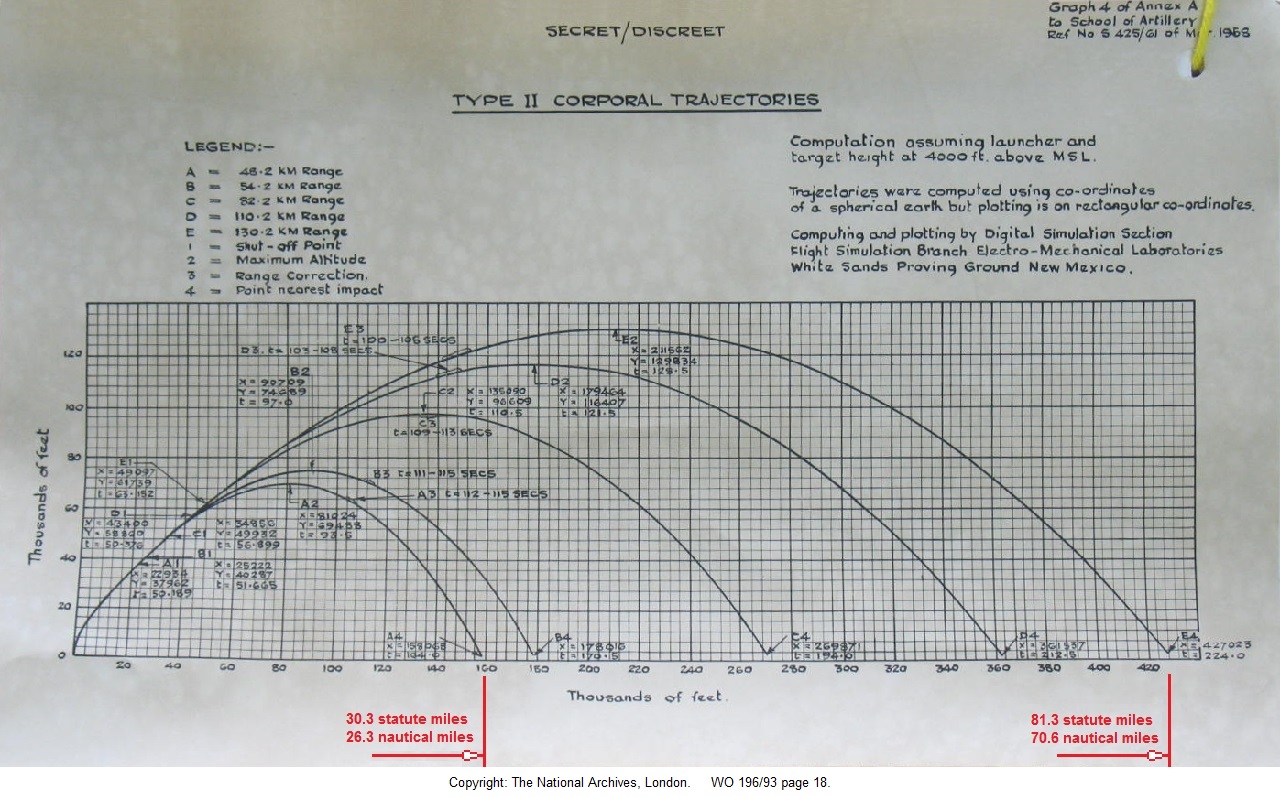
|
RANGE
TIME TO MOTOR SHUT-OFF
TIME TO RANGE CORRECTION
TIME TO TARGET
Statute miles
seconds
seconds
seconds
_________________________________________________________________________________
29 50.189
112-115
104.0
33 51.665
112-115
170.5
51 56.899
109-113
194.0
68 60.376
103-108
212.5
80 63.152
100-106
224.0
Source: TNA, London. WO 196/93 p18. Introduction to the subject of the vulnerability of CORPORAL (US surface to surface guided weapon system) to electronic countermeasures.
|
Although early units equipped with Corporal were complex, large and somewhat unwieldy, they could move around the rear battlefield into relatively discrete locations; probably pre-surveyed, and could shoot and move on with a dexterity that was impossible for large formations of conventional medium artillery, and super-heavy guns. One example is the German offensive of Spring 1918 when 6.600 artillery pieces were deployed. (18) Moving such large and unwieldy formations on the battlefield was staggeringly difficult, not to mention the ammunition supply chain for 6,600 guns, firing 700,000 shells per hour (19) sustained for several hours at a rate approaching 703,000 tons of shells per day (20) and moving on roads that would certainly be choked with refugees. An extreme example perhaps, but compared to formations of such size, moving a few units of Corporal SSMs each with 36 vehicles in the unit supply chain was simple.
One further example. Over 6000 German V2 rockets were manufactured. 3,172 were launched against London, Ipswich, Norwich, Antwerp, Liege and other targets, including eleven launched against a target inside Germany, the bridge at Remagen over the Rhine.(21) Most were fired from mobile launchers, not unlike Corporal, with similar logistical arrangements for fuel and other supplies. Few were ever detected by the overwhelming Allied air dominance over launch sites within range of those targets.(22) V2 launch crews operated virtually unhindered by Allied tactical air forces. With adequate concealment, Corporal could operate in a similar manner.
As the first of several generations of western tactical nuclear missiles Corporal SSMs were very much a learning exercise for designers, engineers, front-line soldiers, and the staff officers at army HQ. These new weapons eliminated the requirement for large numbers of medium and heavy guns, their enormous stockpiles of ammunition and associated supply chains; all of these themselves being likely atomic targets. In addition, they reduced dependence on air forces, good flying weather, and met the requirement of field commanders for a relatively invulnerable, all-weather, all-conditions, always-ready, always-available weapon under their direct control. What's not to like about that?
Of course air force commanders opposed it. (23) There was strong opposition to Corporal purchase from Royal Air Force staffs, mainly because they wanted all the UK fissile material likely to be available for their strategic forces. The scientific manpower needed for development of a Corporal warhead, Violet Vision, a Red Beard derivative, was in short supply. The Army's needs were to the back of the resources queue. Furthermore, the RAF had plans for a new tactical fighter-bomber, the Thin-Wing-Javelin that the RAF claimed would perform the tasks that Corporal would be tasked with. (24) Only with US agreement to supply the British Army (and other NATO allies) with American warheads under dual-key control arrangements, was the opposition from Air Staffs overcome. The Thin-Wing-Javelin aircraft was promoted by the Air Staff as a RAF-controlled-and-operated alternative to a Corporal SSM under Army control. Like it's predecessor the Gloster Javelin, it was originally conceived as an air defence interceptor. Re-roled by the Air Staff as a ground-attack aircraft the Thin-Wing-Javelin was probably unsuited to that role and remained an unbuilt paper project. The complexity required of an aircraft that had to operate over and beyond a hostile battlefield dominated by enemy air forces and SAM missiles doomed not only the Thin-Wing Javelin, but it's successor, the TSR2, also cancelled at a late stage. The performance of these individual aircraft types was not the principal issue at hand; but the hostile conditions they had to operate in over the battlefield; compounded by inter-service rivalries and bickering.
There were several designs on offer, and the Corporal missile was chosen as the first-generation missile for both the US and British armies in Europe. It didn't survive very long before being superseded in US service by Sergeant. The British had in development by then, Blue Water, a smaller, solid-fuelled, air-portable, truck-launched tactical SSM of comparable range to Corporal and armed with a comparable British atomic warhead. In the USSR, the comparable offering to Corporal was the Scud 1, and it, and it's updated solid-fuelled offspring, survived in service somewhat longer.
|
|
Propellant
After Test Round 11, the propellant tanks were designed for an operating mixture ratio of 2.2 for the propulsion system - RFNA (6.5% NO²) as oxidizer and aniline (80%) combined with furfuryl
alcohol (20%) as fuel. This propellant combination, while acceptable for test range use had several tactical disadvantages. When stored in closed containers at the desired upper temperature limit of 160°F (71°C) the oxidizer developed excessively high pressures due to decomposition of HNO³ into oxygen, NO², and water. A starting slug of two parts furfuryl alcohol and one part aniline had been used, but use of a separate starting fuel was undesirable from a tactical standpoint when deployed on the battlefield, requiring supply of two fuels and complicating missile fueling procedure for frontline troops under the stress of battle. Moreover, the running fuel had too high a freezing point (0° C) for field use.
Numerous experiments with propellant combinations finally resulted in the combination in use as of 1958. The propellant mixture as of that date consisted of 46.5% aniline, 46.5% fufuryl alcohol, and 7% hydrazine. SFNA having a nominal composition of 14% NO², 2.5% H²O, 0.6% HF, and the remainder HO³ constituted the oxidizer. Due to changes in density of the propellants, the operating mixture ratio of the missile became 2.13.
The oxidiser was stabilised to inhibit decomposition under certain conditions. The term in use as of May 1960 was "Inhibited Red Fuming Nitric Acid (IRFNA)", the two designations of SRFNA and IRFNA apparently having the same meaning when employed in reference to the oxidizing component of Corporal's propellant combination.
Preparation, and especially fuelling, was hazardous for the launch crews. To minimize errors at the launch site, the RFNA oxidizer and the aniline fuel were transported on separate vehicles in pre-measured containers that eliminated any possibility of over-fuelling. These containers were carefully filled and weighed at a supply base well to the rear of frontlines. Fuelling was done before erection with the missile loaded horizontally on the erector vehicle. Pressurization of fuel and oxidizer tanks was done after missile erection with compressed air supplied from an air cylinder truck and a back-up generator truck. Introduction of Corporal Type II saw fuel composition change to a final configuration of 46.5% aniline, 46.5% fufuryl alcohol, and 7% hydrazine.(25)
Fuelling Corporal held horizontally on the erector.
Source: US Army. Edited Brian Burnell.
Colour added for clarity. Colour does not denote actual colour.
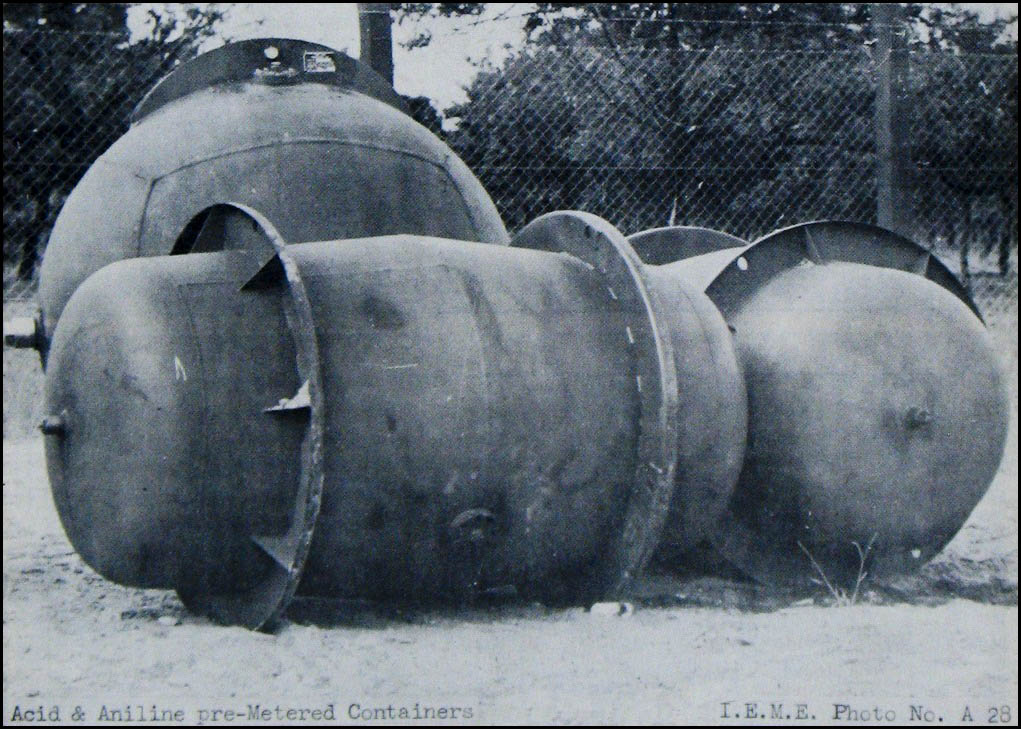 Acid and aniline flasks.
Acid and aniline flasks.
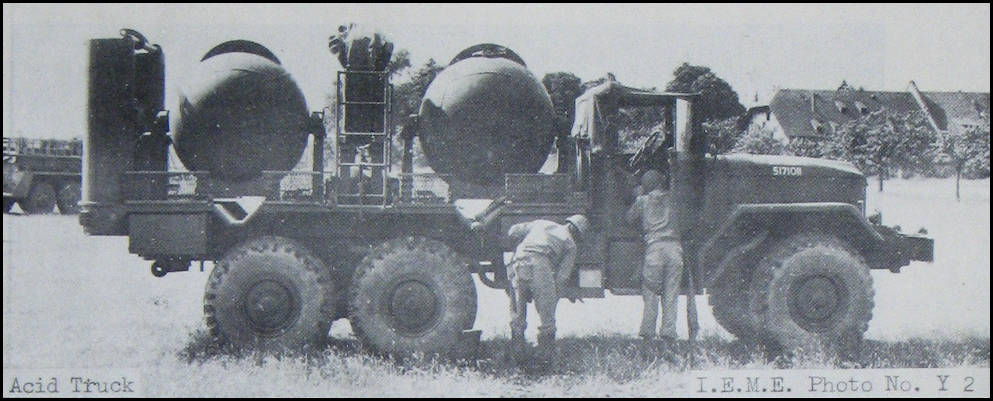 Acid truck.
Acid truck.
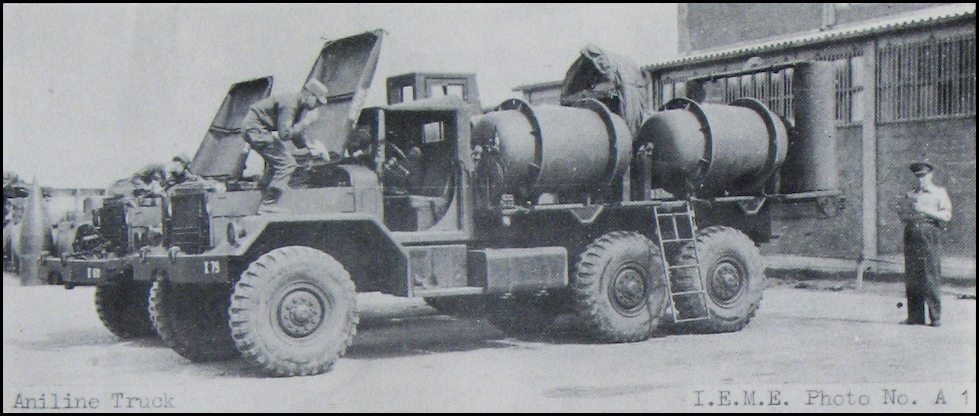 Aniline truck.
Aniline truck.
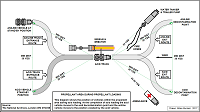 British Army propellant loading drill. Source: TNA WO 279/249 p69.
British Army propellant loading drill. Source: TNA WO 279/249 p69.
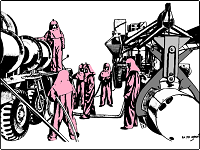
Corporal set up video
|
|
|
Violet Vision warhead
In the early 1950s the British had no access to American nuclear warhead data or engineered designs. The US McMahon Act forbade the transfer of nuclear information to foreign powers and there was no possibility of the United States assisting Britain with design of a warhead for the Corporal missile. Initially, (26) the British War Office (the government Ministry responsible for the Army before re-organisation of the Ministry of Defence) planned to fit a British designed and owned nuclear warhead. This was based upon the Red Beard weapon in development for the Royal Air Force and Royal Navy as a free-fall weapon for their fixed-wing aircraft, and thirdly, as an underwater mine, for deployment by mini-submarines (X-craft). (27) From 1957 yet another variant based on Red Beard was a landmine for the army codenamed Violet Mist. (28) The War Office codenamed the Corporal variant of the Red Beard weapon Violet Vision. (29) However, it soon became clear that the stretched scientific resources available to the British; the scarcity of fissile and other materials, and the priority given to strategic weapons for the RAF meant that production of Violet Vision for Corporal would lag a long way behind availability of the missiles. (30)
Another consideration factored in was the 15 kT yield of Red Beard. (31) Agreements with SACEUR and the Western European Union required a yield of 40 kT for Corporal, a yield that Red Beard was incapable of providing without extensive development, probably further atmospheric nuclear tests, and use of a Composite Core (in the archaic UK jargon of the time, a Mixed Core). (32) As supplied to the RAF and Royal Navy, Red Beard had an all-plutonium core that was interchangeable with Blue Danube (the RAF's first nuclear bomb). That all-plutonium core effectively limited yield to approximately 15 kT because of the risks of predetonation. (33) Until tritium boosting technology became available the only effective method to achieve higher yields using military grade plutonium was to minimize predetonation risks by reducing plutonium quantity to the minimum required to sustain a chain reaction, (approx 2.5 kg) (34) and using a composite core, adding U-235 to achieve the desired yield. U-235 was not susceptible to predetonation, and fissioned more efficiently in a composite core when exposed to the copious and more energetic free neutrons generated by fissioning plutonium. Because free neutrons produced by fissioning plutonium were more energetic than those produced by U-235, they created an environment where U-235 could fission faster, more completely and more efficiently than U-235 could manage alone. So a composite core offered the only prospect at that time of ensuring that a Violet Vision warhead could yield 40 kT.
While there were British plans for composite cores to be used in some versions of Red Beard, (35) and it is known from declassified official archives that the RAF wanted higher yields for Red Beard of 40 kT or more, (36) there were difficulties. Principally of scarcity of scientific and development resources, with other projects having greater priority; and the strategic bomb programme for the RAF consumed much of the available fissile material; and there were also political objections to tactical weapons yielding more than 10 kilotons that were not resolved until the mid-1960s. Historians generally are agreed that composite core versions of Red Beard never materialized. In any Violet Vision warhead for Corporal prior to the development of tritium-boosting technology, a composite core arrangement would be essential to increase yield to the 40 kT required. (37)
|
Yet another issue was the Army's requirement for IFL (In-Flight-Loading, or In-Flight-Insertion) of the nuclear core after missile launch and after the missile was clear of friendly troops. The design of Red Beard was such that IFL was impossible with the variant designed for the RAF and Royal Navy aircraft bomb without extensive redesign; and redesign solely for Violet Vision was never a possiblity.
The RAF and the Navy had originally specified IFL, but had however compromised on a LML (Last Minute Loading) process, where the nuclear core was inserted by ground crews immediately prior to aircraft take-off. There were studies done on possibilities for LML on Corporal, but the army authorities never agreed to that arrangement.
Redesign to render Red Beard suitable for IFL to meet only the Army's requirement was never a possibility, given the small numbers required by the Army, probably 24 warheads, and the scarcity of scientific and engineering manpower. However, the US W-7 warhead had this critical feature of AIFI (Automatic-In-Flight-Insertion) designed into the weapon from it's conception, and when the W-7 became available to the British Army, plans for Violet Vision were abandoned on 16 May 1957.(38)
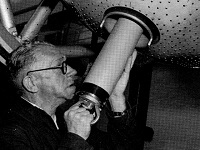 Manual Last-Minute-Loading of a nuclear core (codenamed Gauntlet) in an aircraft bomb, believed to be Red Beard. A difficult task on a rain swept and windswept aircraft carrier deck in the North Atlantic.
Manual Last-Minute-Loading of a nuclear core (codenamed Gauntlet) in an aircraft bomb, believed to be Red Beard. A difficult task on a rain swept and windswept aircraft carrier deck in the North Atlantic.
Source: RAF Historical Society.
|
|
|
W-7 warhead
A solution found was similar to the Project E arrangements used to supply US bombs for RAF aircraft until British weapons became available. In the case of the British Army, this arrangement was initially directly negotiated with the US Army in Europe and known as the Heidelberg Agreement (39) and became permanent, in the sense that the British Army never deployed a nuclear weapon owned by, and subject to the sole national control of the UK. Instead, the arrangement that began with Corporal, and persisted until after the end of the Cold War, was that the British Army was assigned US-owned nuclear weapons from US stocks pre-positioned in Europe under the control of SACEUR, and kept in the custody of US forces until a Presidential Release. There were advantages to the British Army, the Canadian Army, and those other European NATO allies equipped with Corporal, Honest John or other SSMs in the standardization that followed from this; and the costs of these warheads was borne by the United States. The costs borne by the British Army were small, being limited to the construction and maintenance costs of the storage facility and accommodation for the custodial and maintenance crews of the US Army integrated into British artillery and field engineer units; ADMs (Atomic Demolition Munitions) were also supplied (40) and were deployed with Royal Engineer field regiments. For the British and Canadian armies who shared common nuclear ammunition storage facilities, no separate storage agreement with the West Germans was necessary as the W-7 warheads assigned to Corporal, and later the Honest John missiles remained in American custody up to the point of Presidential Release for use; a point that was of course never reached.
British Corporal units were armed with a US-owned W-7 nuclear fission warhead with a yield of 40 kT. (41) Measuring 30½ inch diameter overall the warhead was fitted using a M56 AK adaptor kit, (42) that was supplied to the British firing units with the warheads from secure special weapons stores in the custody of American forces. These "key-to-the-cupboard" arrangements were similar to the arrangements in place for Project E nuclear weapons supplied for the RAF. Different adaptor kits permitted common stocks of the W-7 warhead to be fitted to aircraft bombs and the Honest John SSM that later supplemented and replaced Corporal in the British Army. (43) US Army warhead storage arrangements were regulated by the Heidelberg Agreements negotiated with the West German authorities and the US Army. (44)
The US W-7 warhead (with a composite core) was already tested and available in sufficient numbers. An added advantage of the W-7 was that stocks of this warhead were retained in Europe after Corporal was retired, because with an adaptor kit it would fit Corporal's successor in US Army service, the Sergeant SSM. With a different adaptor kit the W-7 warhead also fitted the Honest John shorter range SSM that the British Army adopted prior to retirement of Corporal. (45) The advantages of continuity of training and spare parts supply would likely be lost with a Violet Vision warhead. Spare parts were also no doubt aided because the "universal" physics package of the W-7 was common to the Mk.7 aircraft bomb (46) deployed widely in Europe with the USAF, the Royal Air Force, and other NATO Allied air forces, all supplied by the United States on similar "key-to-the-cupboard" arrangements as for Corporal. Many W-7 warheads for Corporal were in fact obtained by removing them from Mk.7 aircraft bombs. (47)
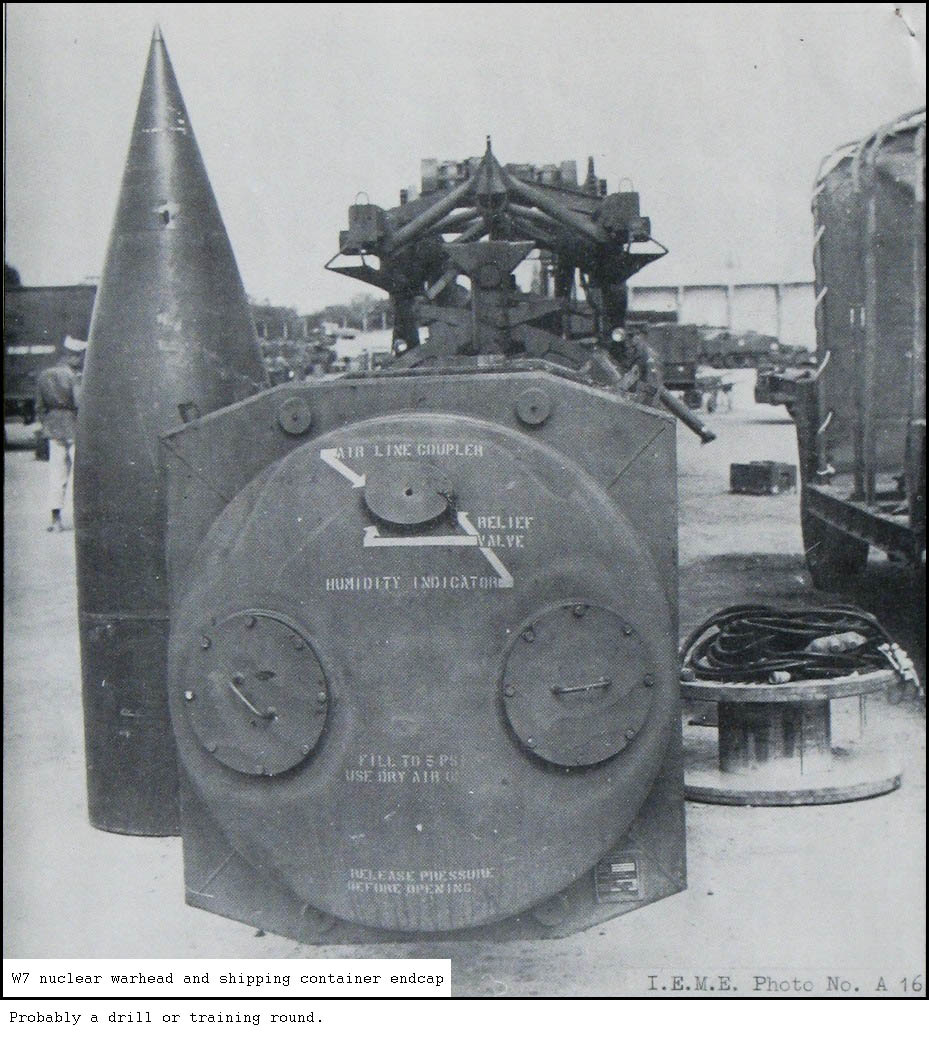 Nose section for the W-7 warhead and its transportation container.
Nose section for the W-7 warhead and its transportation container.
Source: TNA SUPP 26/73.
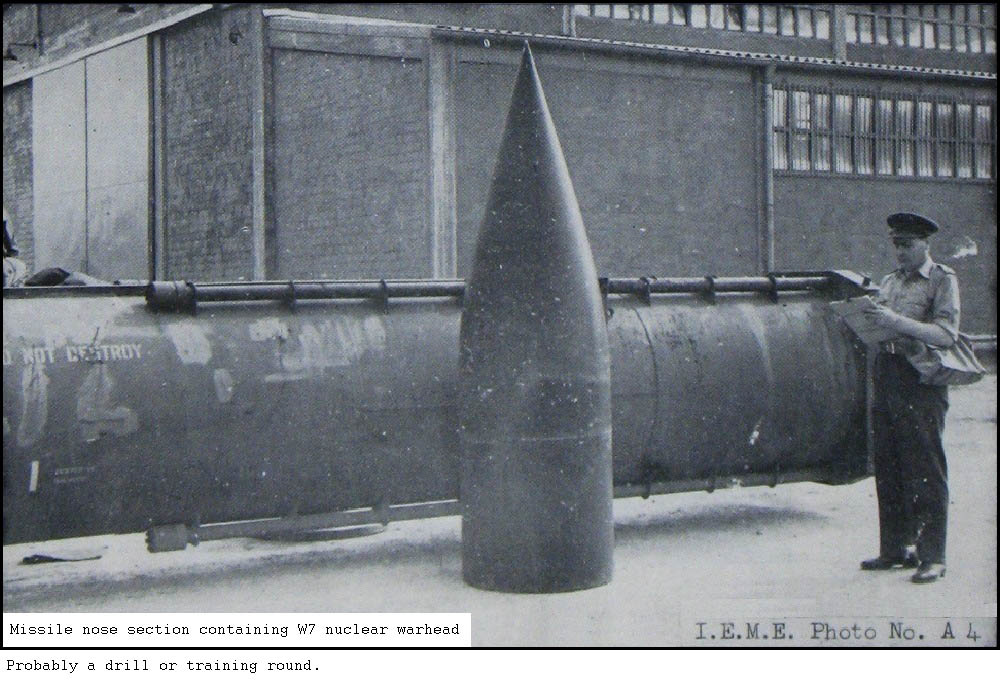 Nose section for the W-7 warhead.
Nose section for the W-7 warhead.
Source: TNA SUPP 26/73.
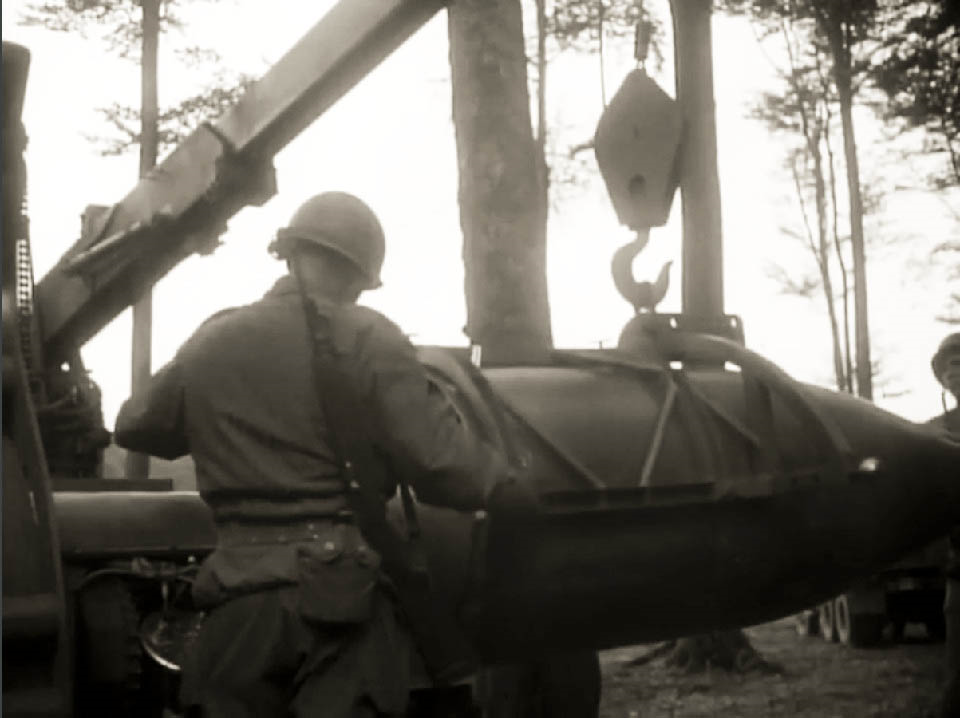 Mating a W-7 warhead to Corporal on field exercise.
Mating a W-7 warhead to Corporal on field exercise.
Source: US Army video.
See it on video
|
|
|
W-7 warhead origins
Like the Corporal missile itself the first of it's kind, the W-7 warhead was also a first of kind stemming from the W-5 strategic bomb with which it shared numerous components. (48)
The W-5 strategic bomb was the first serious effort to produce a bomb smaller and lighter than the Mk.III strategic bomb first used at the Trinity test and Nagasaki and its updated version the Mk.4. The purpose being to permit carriage in smaller aircraft than the ponderous B-29, B-50 and enormous B-36 piston-engined bombers.(49)
The W-7 was at first, an unintended outcome of that process,(50) and resulted in the first atomic warhead small enough and light enough to be carried by a ballistic missile;(51) a problem that aspirant nuclear states such as North Korea still struggle with. Although approximately the weight of a small car the W-7 was the beginnings of miniaturisation.(52) It was produced in very large numbers(53) in the form of a bomb small enough to be carried by single-seat fighter-bombers of the US Air Force and US Navy carrier-borne aircraft.(54) It was also produced as an anti-submarine depth bomb;(55) as a warhead for anti-aircraft missiles;(56) and as a warhead for Corporal, Honest John and Sergeant SSMs(57) in very large numbers and supplied under "key-to-the-cupboard" arrangements to the British, Belgian, Canadian, Dutch, German and other NATO allies.(58) Interchangeability of components between variants was a significant feature of this successful design.(59)
Mk.7 aircraft bomb
Corporal SSM warhead
Sergeant SSM warhead
Honest John SSM warhead
Nike Hercules SAM warhead
Boar rocket-powered stand-off bomb
Project B ADM (Atomic Demolition Munition)
Betty NDB (Nuclear [anti-submarine] Depth Bomb)
Another first for both the W-5 and W-7 was the incorporation of AIFI (Automatic In-Flight-Insertion)(60) and also retraction. The nuclear core was inserted along the warhead's horizontal axis by means of a electrically-powered mechanical screw jack arrangement,(61) and could be retracted in the same manner,(62) alllowing a bomb to be jettisoned in a safe condition with the nuclear core withdrawn.(63) A feature that fully met the British Army requirement, and that the Violet Vision warhead was not capable of. Access to the AIFI mechanisn was via the W-5 bomb opening nose doors, or in the case of the W-7 bomb by removal of the nose cowl.(64) Access to the Corporal warhead AIFI mechanism was by a similar route, because Corporal's warhead and the aircraft bomb's warhead were swappable.(65) Without AIFI it is doubtful whether Corporal would be a viable weapon because an essential safety requirement was for the missile to be unarmed at the most dangerous part of it's flight, at launch, and in powered flight as it rose above friendly troops in the frontline. Arming could be deferred until the missile was over enemy-held ground.(66) AIFI made that possible.
Another first for both the W-5 and W-7 was a 92-lens implosion sphere,(67) and the key to a substantially smaller and lighter warhead, resulting in part from the shallower and flatter lenses.(68)
Unlike conventional HE bombs nuclear bombs require considerable amounts of electrical power to detonate the weapon and to power the complex fusing arrangements. Early US and British weapons used lead-acid batteries. Little Boy, Fat Man, Mk.III, Mk.4 and the British Blue Danube all used lead-acid batteries;(69) although as aircraft-delivered bombs they also drew power from aircraft supplies, primarily to charge the bomb capacitors required for the detonators. External power supplies were not of course possible with a missile warhead. Lead-acid batteries were not a good choice for a missile warhead especially, because unlike a bomb, the warhead was not always orientated in the same plane, but often rotated 90° or more, a practice that lead-acid batteries were not well-suited for with their propensity for electrolyte spillage, or for the extreme vibration encountered at missile launch. Holding a charge was another serious issue where warheads might be held at readiness to fire for up to 90 days, and requiring frequent charging or replacement. Weight was an inconvenience too, especially for a missile warhead.
The deficiencies of lead-acid batteries prompted a search for alternatives, and the British adopted a ram-air generator for their second and third designs; Red Beard and Yellow Sun, before adopting thermal batteries for later designs. In the United States there were experiments with silver peroxide-zinc batteries(70) before a nickel-cadmium (Ni-Cad) solution was adopted for the Mk.7 bomb and the W-7 warhead.(71) These MC-193 Ni-Cad batteries held a charge for up to 240 days improving operational flexibility, and was yet another technological and operational step forward for the W-7.
Composite core
92-lens implosion system
First use of Ni-Cad batteries in a nuclear warhead.
Components swappable between Army, Navy & Air Force
Components swappable between bombs, NDBs, SAM & SSM warheads
Electrically-powered mechanical in-flight-insertion & retraction of core
First warhead small and light enough for use on a tactical ballistic missile.
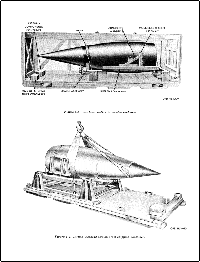 Lifting a W-7 warhead from plywood transportation crate.
Lifting a W-7 warhead from plywood transportation crate.
Source: US Army.
Edited Brian Burnell.
 Opening the nose cone of the W-7.
Opening the nose cone of the W-7.
Source: US Army.
Edited Brian Burnell.
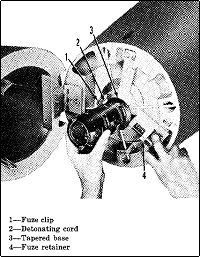 Nose cone opened exposing fuze.
Nose cone opened exposing fuze.
Source: US Army.
Edited Brian Burnell.
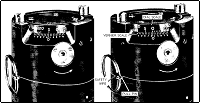 Minimum and max time fuze setting.
Minimum and max time fuze setting.
Source: US Army.
Edited Brian Burnell.
This is an illustration of a timer fuze for a chemical (gas) warhead used on the MGR-1A and MGR-1B Honest John SSM.
It is likely to be almost identical to warhead fuzes fitted to Corporal.
W-7 warheads were "swappable" between Corporal and Honest John, and an essential prerequisite to swap warheads is that centre-of-gravity, size, weight and other physical characteristics are identical to avoid compromising the ballistic characteristics of both Corporal and Honest John.
That applies also to the HE and gas warheads used on Honest John, but not on Corporal.
|
|
|
Control, accuracy, arming and reliability
For a missile to travel an accurate course from launcher to target requires control and guidance systems. Control, which means keeping the missile stable in flight, is relatively easy. From the beginning, Corporal designers adapted autopilots similar to those used in piloted aircraft, and developed pneumatic components to replace existing hydraulic units used in the German V2; and like in the V2, while the rocket motor was burning, the missile was controlled by vanes exposed to the rocket exhaust, and aerodynamic control surfaces on the rear of the stub fins. These fin surfaces offered limited maneouvrability after motor shut-down and unusually for a ballistic missile, there was a degree of controlled manouvrability as the missile re-entered the atmosphere. (72) The autopilot generally operated successfully, and allied to the rocket exhaust vanes and fin surfaces established the basic elements of missile control.
The guidance system proved more complicated. Designers at the Jet Propulsion Laboratory (JPL) were influenced by the only missile used in combat, the German V-2, However demands from the US Army for better accuracy required rather more than the system used in the V2 which used a simple, self-contained, inertial guidance system. When inertial signals indicated the V2 had reached the proper point in its flight, the motor was shut off; this point was analogous to the moment an artillery shell leaves the muzzle of a gun. The shell or missile then coasted on a ballistic trajectory toward the target (a very large city).
In ideal circumstances the missile would fall within the target city; but many uncertainties, particularly air density and wind, would lead to large errors, especially in azimuth. Those V-2s that were successful at launch (approx 60%) had a circular error probability (CEP) of 25 to 35 miles.(73)
However, the US Army wanted a missile with a CEP of at most a half mile (880 yards)(74) requiring more elaborate guidance systems, particularly an all-inertial system that would guide the missile all the way from the launcher to the target. Such a system offered simplicity, reliability, and invulnerability to enemy countermeasures, and its relative invulnerability made it desirable to Army staffs. However, in the circumstances of the late 1940s, it appeared unattainable at a reasonable cost in money or development time.(75)
Instead, Corporal proceeded along lines adopted by the German V2 developers who had experimented with a radio-command guidance system. For these experimental V2 systems, a ground-based radar and a Doppler system would track the position and velocity of the missile. This information would then be used to issue commands to keep the V2 missile generally on course. Refining the system beyond its German origins, Corporal designers added a tracking radar, which, in conjunction with its computer, would make precise measurements of position and apply corrections in azimuth. A Doppler radar measured speed and at an appropriate moment shut down the motor. The missile then, in theory would coast on a ballistic trajectory to the target. These units guided the missile to its apogee, but drag uncertainties and unpredictable atmospheric conditions late in flight could cause a range-to-target error of up to two miles. JPL therefore added a range correction system that measured deviations near the apogee and manoeuvered the missile after re-entry using the stub fins to eliminate some of the uncertainty, and improving range accuracy.
So essentially, Corporal after launch was guided in azimuth by radar while under power; and Doppler radar measured velocity and position to determine motor shut-off time, which in turn determined range to target, with some minor correction after motor shut-down by the stub fin control surfaces.(76)
"Range Correction" after re-entry deserves some explanation. As Corporal ascended to apogee, the inaccuracies caused by imperfectly calculated drag and unmeasureable wind were measured by radar and the doppler set. Corrections were then calculated by the ground-based computer and transmitted to the inertial autopilot. There, the corrections were stored in the autopilot until after atmospheric re-entry when the stub fin control surfaces became operable, and the corrections applied.(77) Of course, on a real battlefield, these momentary transmissions were vulnerable to electronic jamming and other countermeasures.
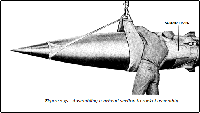 Assembling the W-7 warhead to the missile.
Assembling the W-7 warhead to the missile.
Source: US Army.
Edited Brian Burnell.
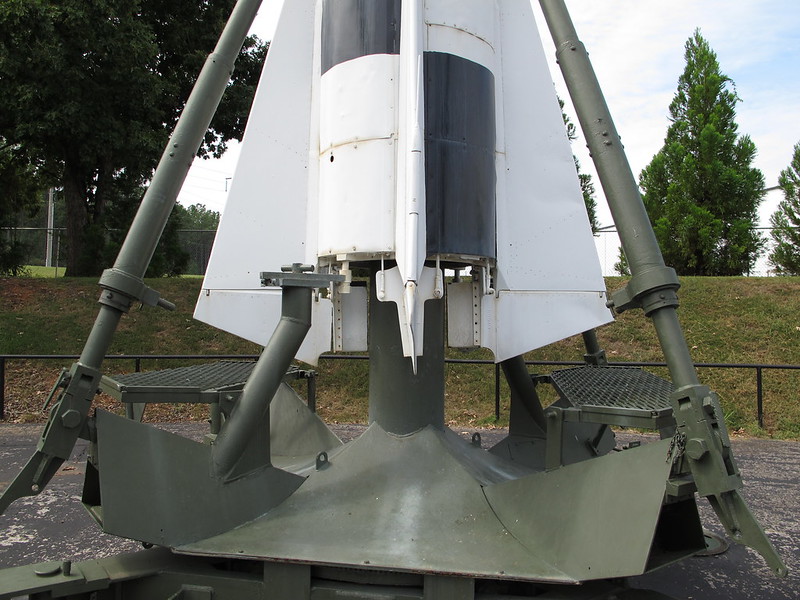 Steering vanes projecting into the rocket exhaust and movable fin surfaces are clearly visible here. Source: Flickr.
Steering vanes projecting into the rocket exhaust and movable fin surfaces are clearly visible here. Source: Flickr.
 Steering vanes projecting into the rocket exhaust and movable fin surfaces are clearly visible here. Source: Flickr.
Steering vanes projecting into the rocket exhaust and movable fin surfaces are clearly visible here. Source: Flickr.
|
|
|
US Army and British Army practice firings show that as expected of all long-range artillery systems, whether conventional guns, or rockets, accuracy in azimuth was always considerably better than accuracy in range. For example range accuracy in naval big-gun plunging fire at extreme ranges was always poorer than accuracy in azimuth. Which is why the traditional naval tactic of "crossing-the-tee" was so desirable for naval commanders in battle. Additional to the benefit of being able to bring all their big guns to bear, while an enemy could not; crossing-the-tee made errors in range less of an issue, and presented gunners with targets eight or ten times larger in range than azimuth and consequently were easier to hit. (78) So it was always the case that range inaccuracies with Corporal firings were always greater than inaccuracies in azimuth.
The figures shown below suggest that accuracy was within reasonable limits for the period and the state of the technology. However, the figures show only those firings that landed within 1000 metres of the target. Those firings that did not are not recorded. That number could be one, or one thousand. However, it is emphasised that rocket-delivered ordnance was a new technology, with much to learn, especially of upper atmospheric winds and temperatures. Improvement in accuracy came partly with improvements to weather prediction, as it did with the accuracy of long-range guns, and good quality training played a large part in improving accuracy, as did the introduction of simulators in training.(79)
Approximately 400 Corporal missiles had been fired on test by the end of 1957. The most recent firings to the end of 1957 demonstrated that the system had a CEP of less than an acceptable 300 meters and an in-flight reliability of approximately 75 per cent as compared to less than 50 per cent in 1955.(80)
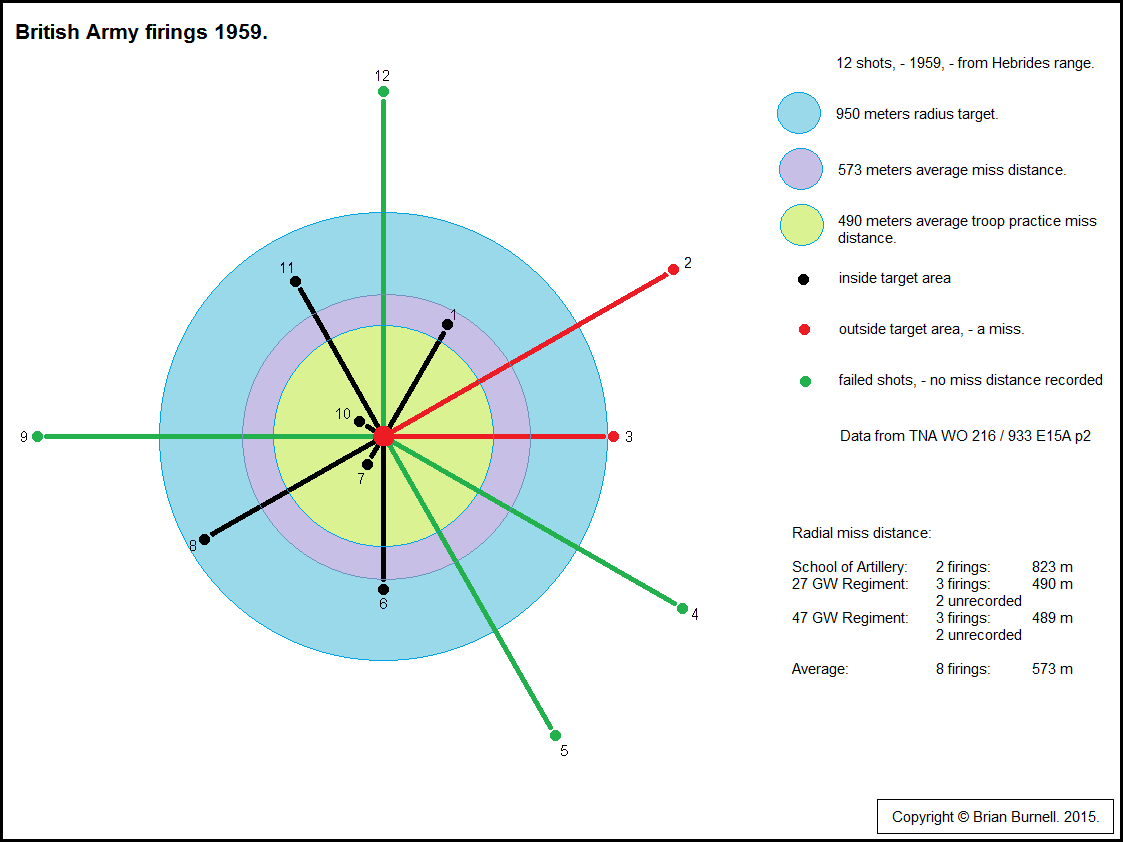 British Army 1959 training firings. Accuracy improved in later years. Source: TNA WO 216/933 E15A.
British Army 1959 training firings. Accuracy improved in later years. Source: TNA WO 216/933 E15A.
|
|
US Army troop practice 1955-59 fall of shot at short, medium and long range, and finally all shots merged. 127 shots, 126 of which were the earlier Type 1 less accurate missile.
Troops were from 15 different regiments, with the normal level of training given to artillery units. US battalions had two batteries (companies) each equipped with two launchers and two launch crews.
Battalions were issued 4 to 5 practice missiles annually. Each launch crew would fire no more than one practice missile per year.
Introduction of the improved Type II missile (Type IIA in the British Army) further improved accuracy and reliability.
A British artillery regiment was nominally equivalent to one US artillery battalion, with similar levels of manpower.
Source: TNA DEFE 15/913.
Even in aviation, simulators were in their infancy. The British considered simulator purchase for Corporal training, but nevertheless there was considerable opposition from Army staff officers who maintained with some justification that ballistic rockets were very complex pieces of equipment; that as yet, were not well understood; and that there was much to learn not only by the firing crews, but by the engineering designers and scientists about actual operating practices in the field before simulators could be reliably designed. (81) Army Staff officers believed that simulators were more suited to equipment that was well understood, equipment such as conventional gun artillery; and that simulators were not suitable for training crews in the safe handling of toxic and corrosive liquid fuels; and could never replicate the "fear factor" in crew training with these materials.
Simulators were largely (and incorrectly) seen as a means of reducing the perceived high cost of Corporal training firings. An annual allocation of training rounds worked out at approximately one Corporal round per launcher and crew per annum. Records in the National Archives, London, puts this cost at £35,000 per annum per Corporal regiment. Whereas ammunition use for a conventional medium calibre gun artillery regiment at annual practice camp was costed at £38,500.(82) However, there were other benefits from Corporal regimental practice firings for scientists and engineering designers, who gained much valuable data from troop practice firings, that would otherwise only be obtained by additional and costly development firings.
|
An essential safety requirement was for the missile to be unarmed at the most dangerous part of it's flight, at launch, and in powered flight as it rose above friendly troops in the frontline. Arming was deferred until the missile was over enemy-held ground,(83) and was by means of a radio command signal transmitted only if the azimuth radar indicated that the missile was following the required course in azimuth. Secondly, the doppler radar and the ground-based computer returns were showing that the missile was at the correct speed, height and position along it's predicted track before the arming signal could be transmitted with range correction data at between 100-115 seconds after launch.(84)
Arming was a two-stage process. Firstly, the Cobra (85) nuclear core had to be inserted along with the cut-out segment of the pit,(86) and the HE implosion sphere.(87) This was done using an electrically-powered screw-jack arrangement located in the nose of the warhead.(88) The nuclear core itself was loaded into the insertion mechanism at the servicing and supply depot before issue to the launch crews. The AIFI (Automatic In-Flight-Insertion) mechanism also permitted the nuclear core to be withdrawn from the nuclear pit. In the withdrawn condition there was no possibility of a nuclear detonation. Secondly, the firing circuits needed to be activated and the capacitors charged from the warhead's Ni-Cad batteries. That isn't an instantaneous process; the capapacitors need time to fully charge. Finally, the fuzes were activated.
The W-7 warhead had three basic fuzes, and up to seven fuzing options. A radar fuze or a timer fuze to provide an accurate height-above-ground airburst; and a back-up contact fuze in case of airburst fuze failure.(89)
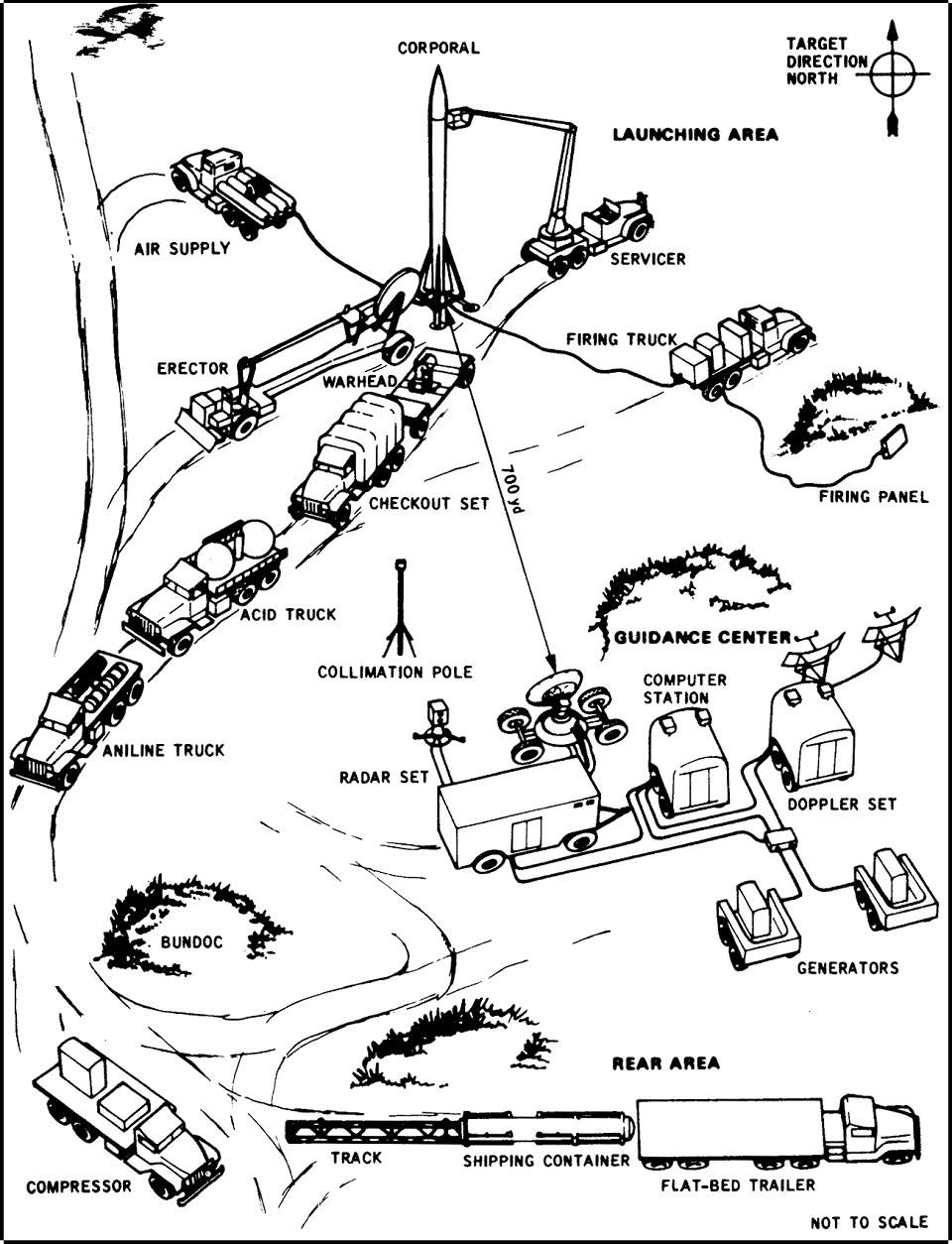 Typical US Army field layout but somewhat compressed in area.
Typical US Army field layout but somewhat compressed in area.
Source: Koppes p59.
|
|
Corporal had numerous critics on several counts, and reliability was one. However, the critics had little access to real data from test firings, and data from troop practice firings was almost non-existent. Furthermore, few, if any of the critics could see the bigger picture of why battlefield missile systems were so essential as detailed above in Military Rationale. That going back to the old ways of massed gun artillery was not possible after the advent of atomic weapons; or failed to take sufficient account that Corporal was a learning exercise for everyone involved, or that there would be unforeseen difficulties as with any new technology.
Reliability as demonstrated by development test firings was problematical because of the nature of development: almost every firing was unique; almost every firing was an advance on the previous one. What data is available is coloured by that process, and known results were predominantly of firings of Corporal I, which of course produced worse results than Corporal II and the version supplied to the British, Corporal IIA, the last missiles off the production line.
At first, CEP was measured in miles; however, this steadily improved. Occasional large errors were however experienced because of failure of some system component, and this continued to be a matter of concern. Much of the available technology was of WW2 vintage. The SCR-584 radar sets for example were standard-issue US Army Signal Corps WW2-vintage surplus shelf-stock items. The Military Characteristics of Corporal were determined by the accuracy limits of these radar sets.(90) The Doppler radar sets were modified WW2 German units acquired from the V2 programme.(91) Old-fashioned thermionic valve technology and vulnerable in a high-vibration environment such as missile launch was the norm. However, with all components working properly, Corporal demonstrated its capability of achieving a CEP of only a few hundred feet. For instance, round 54, fired 23 July 1953 with a radlal error of 96 yds.(92)
In the autumn of 1957 there were 37 firings at White Sands. The overall in-flight reliability of the 37 flights was 51%. The figure of 51% was comparable to the results for the WSMR firings of the previous year.
A statistical reliability analysis of 224 Corporal II rounds fired Oct 1954 to Feb 1959 by White Sands Missile Range (WSMR) personnel and US Army Field Artillery troops showed these results.(93)
WSMR (65 rounds).
CEP of 300 yards or less for successful short and medium range rounds.
CEP of 386 yards for successful long-range rounds.
CEP of 302 yards for all ranges combined for the 32 of 65 successful firings.
62% in-flight reliability.
US Army troop training (159 rounds).
CEP of 300 yards or less of successful short and medium range rounds.
CEP of 359 yards of successful long-range rounds.
CEP of 351 yards overall figure of for all ranges.
60% in-flight reliability.
This was a lower accuracy than that of WSMR rounds, with a CEP of 302 yards.
Range miss distances were significantly different between the three ranges.
Training rounds fired at medium range consistently overshot the target.
Training rounds fired at long range consistently undershot the target.
There was no indication of significant bias either in range or deflection components of miss distances.
At all ranges a standard range miss distance was approx three times greater than the deflection.
Standard deviation in range components of miss distances was three times greater than deflection components for all ranges.
There was a decided upward trend in the reliability of rounds fired in the second half of the program over those fired in the first half.
CEP for rounds fired at the short and medium ranges fell within the required CEP of 300 yards.
CEP for the long-range firings exceeded the required CEP of 300 yards by approximately 76 yards.
CEP was compatible with the 300 yards required by Military Characteristics when all ranges were considered.
61% reliability of the combined WSMR and US Army troop training rounds.
|
|
Warhead numbers in the British Army
Nuclear warhead numbers for Corporal, and tactical missiles generally should not be equated with missile numbers kept in the inventory. The two are quite different and never the same. Some reputable nuclear historians have in the past merely assumed that the initial purchase of 100 missiles plus 13 missiles for schools and other non-operational use equated to 100 warheads.(94) It did not.
Missile numbers were always much greater than warhead numbers because a number of missiles (24 in the case of Corporal)(95) were set aside as War Reserve missiles (plus the usual spares), and warheads did match these War Reserve missiles.
The remainder of the British initial purchase of 113 Corporal missiles were mostly allocated for routine training firings planned over the anticipated service life of the weapon (1958-1966).(96) Thus, as service life came to an end and the training rounds expended, the only remaining missiles would be the 24 War Reserve missiles.
In theory that is, because operational plans constantly changed. There was also a possibility that if war began before service life expired, the remaining training rounds could be used operationally if the US Army authorities made sufficient additional warheads were available for them. These training missiles were interchangeable with War Reseve missiles; the differences being only in the inert ballasted training warheads fitted with sensors and other target accuracy feedback mechanisms. Some of these training rounds were allocated to the Royal Artillery School of Artillery at Larkhill, Wiltshire, along with operational spares of ground equipment.
There were also six missiles ordered and paid for by the Ministry of Supply and intended for use in various ways for development and training purposes. These missiles were not intended to be fired and after use in training schools for mechanics and other servicing personnel they would become sub-standard for firing purposes. Some of these six missiles were dismembered, sectioned and used as school-based ground-training aids, and these six brought the total purchase to 113.
W-7 warheads for British Army Corporal units were held in US custody and the number allocated to British artillery units was initially twentyfour (24).(97) The original British Army requirement for a British-made and British-owned Violet Vision warhead based on the Red Beard design was also twentyfour.(98) Additionally (with Violet Vision) there would be the usual allocation of 10% operational spares in military hands, and a similar percentage of warheads always in the civilian servicing chain. Operational spares and supply chain spares are harder to quantify in the case of the US W-7 warhead since these were interchangeable with other missiles and aircraft bombs used by the RAF, RCAF, USAF and other NATO allies. Nor is much known about interchangeability of W-7 warheads in stockpiles managed by the US Army and the US Air Force in Europe.
The US W-7 eventually chosen by the British was serviced in Special Storage Areas (SSA) in Germany by US Army servicers, and always kept in US Army custody until a Presidential Release. These SSAs were subject to the Heidelburg Agreement as referred to above.(99) As American stocks in Europe built up the numbers allocated to British units could increase as the NATO joint targetting plan was reviewed periodically. On occasion that not meet with British Treasury approval because as more warheads were allocated, more missiles were required, and these were purchased in dollars. That was a particular issue with Honest John when US warhead allocation doubled, requiring additional missile purchases.
And in the case of Corporal, it was even more confused because the same W-7 warhead could be used (with a different adaptor kit) on Corporal, Honest John, the planned Sergeant SSM, and even inserted into the US Mk.7 aircraft free fall bomb supplied to RAF Canberra tactical bombers based in Germany. Some W-7 warheads for British and US Corporal units were fabricated from warheads taken from the Mk-7 aircraft bomb.
War Reserve missiles allocated to each of two Corporal artillery units was limited to four; two missiles per launcher, and two launchers per regiment. Other War Reserve missile stocks were held in the supply chain where they were checked out by REME engineering staff at a base workshop (often tented and close to the firing units) before being transported to forward artillery firing units as required. Similar arrangements were used for fuel and oxidizer supply. The two toxic liquids were dispensed into dedicated containers in measured and weighed quantities at a base supply unit before being supplied to firing units. This arrangement guarded against over-fuelling at the firing units.
Warheads were supplied fully serviced direct to artillery firing units from the SSAs using similar arrangements, with one additional element. A nuclear transport team from the Royal Corps of Transport (and predecessor and successor units) was supplemented by a dedicated military armoured escort. Initially the escort would be formed from a line regiment, or for some time, a unit from the Royal Maltese Artillery (an arrangement terminated after Maltese independence). A later arrangement was of a dedicated Royal Logistics Corps unit with its own integral military escort.
|
|
Tactical deployment in the British Army
|
|
Photo Gallery
The first tranche of photographs in poor quality black and white were taken in Germany in 1956 by a British Army REME (Royal Electrical and Mechanical Engineers) officer (Major J.Veyers) tasked with writing a report for staff officers about the equipment needed to form two regiments of British artillery after purchasing Corporal missiles for the British Army of the Rhine, based in West Germany. The officer was invited by a German-based US Army Corporal regiment so that he might see how the US Army equipped its regiments. He was permitted to photograph freely while the US Army unit was on exercise in the field. These photographs are the result, and can be found now in the National Archives, London, in a folder labelled SUPP 26/73. Although every effort has been made to remaster and crop them, quality remains poor. Originally copyright, Crown Copyright expired after fifty years, in 2006.
|

|

|

|

|

|

|

|

|

|

|

|

|

|

|

|

|

|

|

|

|

|

|

|

|

|

|

|

|

|

|

|

|

|

|

|

|

|

|

|

|

|

|

|

|

|

|

|

|

|

|

|

|

|

|

|

|

|

|

|

|

|

|

|

|

|

|

|

|

|

|

|

|

|

|

|

|

|

|

|

|

|

|

|

|

|

|

|

|

|

|

|

|

|

|

|

|

|

|

|

|

|

|

|

|

|

|

|

|

|

|

|

|

|

|

|

|

|

|

|

|

|

|

|

|

|

|

|

|

|

|

|

|

|

|

|

|

|

|

|

|

|

|

|

|

|

|

|

|

|

|

|

|

|

|

|

|

|

|

|

|

|

|

|

|

|

|

|

|

|

|

|

|

|

|

|

|

|

|

|

|

|

|

|

|

|

|

|

|

|

|

|

|

|

|

|

|

|

|

|

|

|

|

|

|

|

|

|

|

|

|

|

|

|

|

|

|

|

|

|

|

|

|

|

|

|
|
References
-
Clayton R Koppes. JPL and the History of the American Space Program, A history of the Jet Propulsion Laboratory.
ISBN 0-300-02408-8 Pub: Yale University Press, 1982. Especially Chapters 1-5.
- James W. Bragg. Development of the Corporal: The Embryo of the Army Missile Program. Historical Monograph #4.1961.
Pub: Dept of the Army, Army Ordnance Missile Command, Redstone Arsenal, Alabama. 1961.
- Dept of the Army. Technical Report. Ordnance Guided Missile & Rocket Programs. Vol. 111, Corporal Field Artillery Guided
Missile System, inception through 30 June 1955.
- Dept of the Army. Surface-to-Surface Reference Book. Section 11: Chronology of the Corporal Missile System.
U.S. Army Ordnance Missile Command, Redstone Arsenal, Alabama, December 1959.
- Dept of the Army. Chronological history of Army activities in the missile/satellite field, 1943-1958.
Pamphlet Nos 70-10. Headquarters, Department of the Army,17 September 1958.
- Dept of the Army. Chronology of Significant Events in the Corporal Program.
A typewritten document located in the Sergeant-Corporal Projects Office, R&D Operations, ABMA.
- Dept of the Army Development of the Corporal: the embryo of the army missile program,
vol. 1 (PDF). Army Ballistic Missile Agency.
Dept of the Army. Development of the Corporal: the embryo of the army missile program, vol. 2 (PDF). Army Ballistic Missile Agency.
Dept of the Army. MGR-1A & MGR-1B Honest John Operator & Organisation Maintenance Manual
David French. Army, Empire, and Cold War. The British Army and Military Policy, 1945-1971.Pub: Oxford University Press, 2012. ISBN-9780199548231
Martin Kitchen. The German Offensives of 1918. Publisher: Tempus. 2001. ISBN 0752417991.
Dean Acheson. Present at the Creation. Pub: Norton, New York (1969). ISBN 9780393074482
Stephen Twigge & Planning Armageddon, Britain the United States and the Command of Western Nuclear Forces 1945-1964.
Len Scott. Pub: Routledge 2014. ISBN: 9781138002302
Watson & Rinaldi The British Army in Germany (BAOR and After): An Organisational History 1947-2004.Pub: Tiger Lily, 2005. ISBN: 0-9720296-9-9
Peter Duignan NATO: Its Past, Present, and Future.Pub: Hoover Institution Press, Stanford University, 2000. ISBN: 9780817997823
Dr Richard Moore. The Real Meaning of the Words: a Pedantic Glossary of British Nuclear Weapons.
Dr John Clearwater Canadian Nuclear Weapons. The Untold Story of Canada's Cold War Arsenal.Pub: Dundurn Press, Toronto, 1998. ISBN 1-55002-299-7
Yogi Shan. Death's Twilight Kingdom. The Secret World of US Nuclear Weapon "Design Data". Especially Part B,The Early (1945 - 1962) US Nuclear Tests. The lack of page numbers and an index prevents using this book more extensively as a reference source, good though it is. ISBN 978 151 1674829
Norris, Burrows, Nuclear Weapons Databook Vol V, British, French and Chinese Nuclear Weapons. p 82-83.
& Fieldhouse Pub: NRDC 1994. ISBN: 081331612X
|
Footnotes

- back
Chuck Hansen. Swords of Armageddon. vol 7, p240. 18 December 1950.
- back James W. Bragg Development of the Corporal: The Embryo of the Army Missile Program. Vol 1, p xvii.
Historical Monograph #4. Three battalions activated March 1952. Pub: Army Ordnance Missile Command, Redstone Arsenal, 1961.
- back James W. Bragg Development of the Corporal: The Embryo of the Army Missile Program. Vol 1, p 273.
"Corporal was, indeed, a pioneer, but, according to available information, field officers failed to sell that idea to their men, since the officers themselves apparently failed to understand that they were ushering in the missile age, [and] push-button warfare."
- back James W. Bragg Development of the Corporal: The Embryo of the Army Missile Program. Vol 1, p xiii
"22 May 1947 Corporal E, first US surface-to-surface guided ballistic missile, accepted guidance corrections, and attained a range of 63.5 miles and an altitude of 129,000 feet; it was powered by;the first US developed and tested large-thrust rocket motor, essentially a scaled-up WAC motor, and having 20,000-pound thrust, burning a RFNA-aniline-furfuryl alcohol propellant combination."
- back Clayton R Koppes JPL and the History of the American Space Program, A history of the Jet Propulsion Laboratory.
- back James W. Bragg Development of the Corporal: The Embryo of the Army Missile Program. Vol 1, p xiii
18 Jan 1950 JPL was directed by Chief of Ordnance to expedite Corporal development toward the goal of an interim tactical guided missile.
- back Clayton R Koppes JPL and the History of the American Space Program, A history of the Jet Propulsion Laboratory.
- back General Sir John Hackett. The Third World War, August 1985: A Future History.
ISBN: 978-0-722-14185-4. Pub: Little, Brown Book Group, London, 1988.
- back General Sir John Hackett. The Third World War - The Untold Story.
ISBN: 978-0-283-98863-9. Pub: Pan Macmillan, London, 1982.
back General Sir Richard Shirreff. 2017 War with Russia.ISBN: 978-1-473-63222-6. Pub: Hodder & Stoughton, London, 2016. An update on likely Russian tactics in the 21st century, written by a recently retired Deputy Supreme Allied Commander Europe. The highest rank that a British NATO officer can aspire to.
- back TNA WO 216/934 E8c p0-1. Corps tactical battle in nuclear war and future of nuclear deterrent and its deployment 1956-59.
back TNA WO 216/934 E8c p2-3. Ditto. Page 2 & 3.
back TNA WO 216/934 E8c p4-5. Ditto. Page 4 & 5.
back TNA WO 216/934 E8c p6-7. Ditto. Page 6 & 7.
back TNA WO 216/934 E8c p8-9. Ditto. Page 8 & 9.
back TNA WO 216/934 E8c p10-11. Ditto. Page 10 & 11.
back TNA WO 216/934 E8c p12-13 Ditto. Page 12 & 13.
back TNA WO 216/934 E8c p14-15 Ditto. Page 14 & 15.
back TNA WO 216/934 E8c p16-17 Ditto. Page 16 & 17.
back TNA WO 216/934 E8c p18-19 Ditto. Page 18 & 19.
back TNA WO 216/934 E8c p20-21 Ditto. Page 20 & 21.
back TNA WO 216/934 E8c p22-23 Ditto. Page 22 & 23.
back TNA WO 216/934 E8c p24-25 Ditto. Page 24 & 25.
- back TNA WO 216/934 E8c p7 ¶6 Ditto. Page 7 ¶6.
- back
Dean Acheson. Present at the Creation. Pub: Norton, New York (1969). ISBN 9780393074482.
Of Canadian ancestry, Acheson was Secretary of State in the Truman Presidency at the time NATO was created by Foreign Secretary Ernest Bevin, Dean Acheson and others.
- back
Clayton R Koppes JPL and the History of the American Space Program, A history of the Jet Propulsion Laboratory.
ISBN 0-300-02408-8 Pub: Yale University Press, 1982. Chapter 3 page 38.
"... it was the only American-originated rocket that could be quickly turned into a missile weapon."
- back TNA WO 196/93 p16 anx A g1 Introduction to the subject of the vulnerability of Corporal to electronic countermeasures. 1958.
back TNA WO 32/21235 E6 p2 ¶7 Corporal surface-to-surface guided weapon [SSGW]: procurement from USA. 1953-56.
back TNA WO 32/21235 E13A p1 Corporal surface-to-surface guided weapon [SSGW]: procurement from USA. 1953-56.
- back US Army information film M65 280mm guns & 42nd Field Artillery deployed in FDR. 24 guns & 6 Corporal launchers.
- back TNA WO 216/934 E8c p16.28 Corps tactical battle in nuclear war and future of nuclear deterrent and its deployment 1956-59.
- back
StephenTwigge and Len Scott. Planning Armageddon, Britain the United States and the Command of Western Nuclear Forces
1945-1964. p156-157. Pub: Routledge 2014. ISBN: 81138002302
Corporal was deployed in BAOR by 1959. In addition to Corporal, by the end of 1960, BAOR also fielded 12 nuclear-capable 203mm howitzers supplied with US nuclear shells, and an artillery regiment armed with Honest John SSMs supplied with US W-7 warheads.
- back German Spring Offensive 1918 Operation Michael. German offensive preparations. 6,600 guns, 3,500 mortars, etc.
- back German Spring Offensive 1918 3.5 milion shells/5 hrs. 700,000/hour. 29,300 tons/hour calculated using 155mm shell weight.
- back German Spring Offensive 1918 Shell weight equivalent to 5,372 12,000 lb Tallboy or Blockbuster bombs.
- back German V2 Offensive 1944-45 V2 could be launched practically anywhere, roads in forests being a particular favourite.
- back German V2 Offensive 1944-45 V2 was mobile & small and only one mobile launch site was caught in action by Allied aircraft.
- back TNA WO 216/933 E6A pps 1-3. Corporal ground to ground guided weapon: analysis and results of test firings and
stockpiling of atomic warheads. 1953-59.
- back TNA WO 216/933 E6A pps 1-3. Corporal ground to ground guided weapon: analysis and results of test firings and
stockpiling of atomic warheads. 1953-59.
- back James W Bragg Development of the Corporal: The Embryo of the Army Missile Program. Vol 1, p 169
- back TNA DEFE 13/189. Guided weapons policy 1957-59. Briefing paper for Minister dated 18 January 1957, page 1.
back StephenTwigge and Len Scott Planning Armageddon, Britain the United States and the Command of Western Nuclear Forces1945-1964. p196 note 40. Pub: Routledge 2014. ISBN: 9781138002302
- back TNA AVIA 65/1107 E17. Corporal Violet Vision warhead requirements. 1954-57.
- back Dr Richard Moore. The Real Meaning of the Words: a Pedantic Glossary of British Nuclear Weapons.
- back TNA DEFE 13/189. Guided weapons policy 1957-59. Briefing paper for Minister dated 18 January 1957, page 1.
back TNA DEFE 13/189. Guided weapons policy 1957-59. Briefing paper for Minister dated 18 January 1957, page 2.
back TNA DEFE 13/189. Guided weapons policy 1957-59. Briefing paper for Minister dated 18 January 1957, page 3.
- back TNA WO 32/21235 E42A p1-2. Corporal surface-to-surface guided weapon [SSGW]: procurement from USA. 1953-56.
back TNA WO 32/21235 E66A p1-2. Corporal surface-to-surface guided weapon [SSGW]: procurement from USA. 1953-56.
- back Dr John R Walker. British Nuclear Weapon Stockpiles, 1953–78. RUSI Journal, 156:5, 66-72
(2011).
- back nuclear-weapons.info Composite Core.
- back TNA DEFE 32/3 E4 p1-2. Chiefs of Staff Committee: Secretary's standard file. 1953. Note by Sir William Penney,
Kilotonnage of UK Mk.1 Atom Bomb.
- back nuclear-weapons.info Composite Core Footnote 38.
- back nuclear-weapons.info Composite Core Footnote 38.
- back TNA AVIA 65/1107 E17. Corporal Violet Vision warhead requirements. 1954-57.
- back TNA DEFE 32/3 E13 p7-10. Chiefs of Staff Committee: Secretary's standard file. 1953. Page 9 paragraph 40.
- back TNA AVIA 65/1107 E19. Corporal Violet Vision warhead requirements. 1954-57.
- back TNA WO 216/933 E12A pps 1-3. Corporal ground to ground guided weapon: analysis and results of test firings and
stockpiling of atomic warheads. 1953-59.
- back Robert S Norris, Nuclear Weapons Databook Vol V, British, French and Chinese Nuclear Weapons. pps 82-83.
Andrew S Burrows Pub: Westview Press, Oxford, & the National Resources Defense Council. 1994.
Richard W Fieldhouse ISBN: 0-8133-1612-X
- back nuclearweaponarchive.org Complete list of all US nuclear weapons.
- back TNA DEFE 7/1349 E8 p1-2. War Office production programmes: guided weapons: Corporal. 1958-63.
- back TNA WO 216/933 E4B pps 1-2. Corporal ground to ground guided weapon: analysis and results of test firings and
stockpiling of atomic warheads. 1953-59.
- back TNA DEFE 7/1349 E23 p1. War Office production programmes: guided weapons: Corporal. 1958-63.
back TNA DEFE 7/1349 E24 p1. War Office production programmes: guided weapons: Corporal. 1958-63.
back TNA WO 216/933 E12A p1. Corporal ground to ground guided weapon: analysis and results of test firings and stockpiling of atomic warheads. 1953-59.
- back TNA WO 216/933 E4B p1 #5. Corporal ground to ground guided weapon: analysis and results of test firings and
stockpiling of atomic warheads. 1953-59.
- back Chuck Hansen. Swords of Armageddon. vol 7, p243.
- back Chuck Hansen. Swords of Armageddon. vol 7, p244, 245. See Corporal and W-7 timeline.
- back Chuck Hansen. Swords of Armageddon. vol 6 p183, 207, 208, 211.
- back Chuck Hansen. Swords of Armageddon. vol 6, p146-147
[The] USAF developed a set of military characteristics outlining Air Force requirements for present and future developmental work with respect to FAT MAN [Mk.III and Mk.4] type atomic weapons. These specifications included dimensional maximums of 50 inches in diameter, 300 inches in length, and 6,000 lbs. in weight. These measurements were to be applied to all future USAF bombers beginning with the XB-55.
Data from the Sandstone tests in the spring was still being analyzed, and ways to use the information in new weapons were still being studied. [The] Sandstone [tests] had kindled hopes for smaller, lighter weapons of standard design. The principal benefit of a small-diameter bomb would be delivery aircraft range extension, an increasingly-important factor in light of high-speed turbojet bombers then under development. However, this gain could not be fully realized unless the aircraft was designed from the start for the smaller bomb, which turned out not to be the case: most early Air Force and Navy jet bombers were designed around 60" diameter, 128" long, 10,000 lb. bombs, and smaller, lighter weapons only inadvertently offered range, altitude, speed, and payload benefits, in addition to guided missile warhead utility.
- back Chuck Hansen. Swords of Armageddon. vol 6 p142-147 for the US Navy view, vol 6 p138-186 and p207-233 for
- back Chuck Hansen. Swords of Armageddon. vol 6 p169, 210-211
It is our understanding that the Mk.5 bomb may be carried by existing light bombers, and the "Thor" [Mk.7 bomb] by fighter aircraft, thus opening n entire new range of tactical applications of atomic bombs. Also, the relatively small size and light weight of the warheads of these smaller bombs should greatly ease the problems of designing adequate guided missiles to carry them.Letter dated August 21, 1950, from Sumner T. Pike, Acting Chairman, U.S. Atomic Energy Commission, Washington, D.C., toLt. General Elwood R. Quesada, USAF, Commander, Joint Task Force 3, Washington, D.C.
- back Chuck Hansen. Swords of Armageddon. vol 6 p207-208
- back Chuck Hansen. Swords of Armageddon. vol 6 p207-208
- back Chuck Hansen. Swords of Armageddon. Betty NDB. vol 5 p 266, vol 5 p286 fn424
- back Chuck Hansen. Swords of Armageddon. vol 5 p286 fn424
- back Chuck Hansen. Swords of Armageddon. vol 5 p286 fn424
- back Chuck Hansen. Swords of Armageddon. vol 5 p286 fn424
- back Robert S Norris, Nuclear Weapons Databook Vol V, British, French and Chinese Nuclear Weapons. pps 82-83.
Andrew S Burrows Pub: Westview Press, Oxford, & the National Resources Defense Council. 1994.
Richard W Fieldhouse ISBN: 0-8133-1612-X
- back Chuck Hansen. Swords of Armageddon. vol 6 p183, 207, 208, 209
- back nuclearweaponarchive.org Complete list of all US nuclear weapons.
back Chuck Hansen. Swords of Armageddon. vol 5 p239-240, vol 6 p213, vol 8 p36
- back Chuck Hansen. Swords of Armageddon. vol 8 p36
- back Chuck Hansen. Swords of Armageddon. vol 8 p36
Also see
MGR-1A & MGR-1B HONEST JOHN Operator & Organisation Maintenance Manual printed by the US Army for issue to troops deployed with Honest John SSM missiles. Although Chapter 2 of this manual deals with Honest John, its warhead and fuze-setting and handling issues, readers are reminded that the W-7 warhead was swappable with Corporal, and carried the same fuzes and fitments, and was identical in every way, whether used for Honest John or Corporal.
- back Chuck Hansen. Swords of Armageddon. vol 8 p36
- back Chuck Hansen. Swords of Armageddon. vol 6 p116
- back Chuck Hansen. Swords of Armageddon. vol 7, p243, 244, 245.
See Corporal and W-7 timeline.
- back Chuck Hansen. Swords of Armageddon. vol 8 p37
- back Chuck Hansen. Swords of Armageddon. vol 6 p208
- back
Chuck Hansen. Swords of Armageddon. vol 6 p95, 139, 145
- back TNA AVIA 65/1161 E8 10,000 lb HE MC bomb: development policy. 1954-1958. p1
back Chuck Hansen. Swords of Armageddon. vol 6 p107-107
The MK III [the Nagasaki implosion bomb] could be maintained in combat-ready status for just a short time. The life span of its NT-6 lead-acid batteries, once charged and installed, was only nine days, during which time they had to be repeatedly recharged (the batteries retained their charge for 36 hours at a time).
After nine days, the entire bomb had to be disassembled to remove the chemical batteries, lest they begin to corrode. The batteries were not used to charge the capacitors to ready the weapon's X-unit for arming; initial capacitor charge came from an aircraft power supply. The batteries powered only the fuzing system which first armed then fired the weapon, and replaced capacitor charge that "bled off" after initial charging. Later X-units enhanced delivery aircraft safety by charging the capacitors during the weapon's fall after release over a target.
- back Chuck Hansen. Swords of Armageddon. vol 6 p287.
See Wikipedia Silver Zinc battery.
- back Chuck Hansen. Swords of Armageddon. vol 6 p206.
Late mods of the Mk.6 and Mk.7 bombs [and W-7 warheads] used new MC-193 nickel-cadmium (NiCad) storage batteries that replaced the ER 12-10 lead-acid batteries. The MC-193 required a charging time of only one hour, after which it held a full charge anywhere from one to 240 days, depending on ambient temperature.
- back Bragg.
Development of the Corporal: The Embryo of the Army Missile Program. Chapter IX, p 206/234.
back Koppes. JPL and the History of the American Space Program, A history of the JPL. Chapter 4 page 45.
- back Koppes. JPL and the History of the American Space Program, A history of the JPL. Chapter 4 page 44.
Circular Error Probability (CEP) means that 50% of missiles reaching a target will fall within the CEP. In the case of the German V2, 50% of V2 missiles would fall within a radius of 25-25 miles of the nominal aiming point. See Wikipedia
- back Koppes. JPL and the History of the American Space Program, A history of the JPL. Chapter 4 page 44
- back Koppes. JPL and the History of the American Space Program, A history of the JPL. Chapter 4 page 45
- back Koppes. JPL and the History of the American Space Program, A history of the JPL. Chapter 4 page 45
- back Koppes. JPL and the History of the American Space Program, A history of the JPL. Chapter 4 page 45
back Bragg.
Development of the Corporal: The Embryo of the Army Missile Program p138/160.
Range correction involved a careful measurement of Corporal's velocity and position at the zenith of it's trajectory after most disturbances had already acted. A range-correction signal was then computed and sent to the missile, where it was to be stored until reentry into the atmosphere made corrective maneuvering possible. At a programmed instant, the autopilot began to execute the corrective manouver, and its completion was sensed by doubly integrating the output of appropriate accelerometers. This system, a species of "fine adjustment" to the range, was capable of a maximum correction of 5,000 feet and for that reason could not be tested until late in the flight program, after the gross operation of major controls, such as Doppler, had beed proved.
- back Wikipedia Crossing-the-T. "It also makes ranging errors less critical".
- back TNA DEFE 13/189.
Guided weapons policy 1957-59. Briefing paper for Minister dated 28 May 1957, page 1.
back TNA DEFE 13/189.
Guided weapons policy 1957-59. Briefing paper for Minister dated 28 May 1957, page 2.
- back Koppes. JPL and the History of the American Space Program, A history of the JPL. Chapter 9 page 174.
The US Army had wanted a CEP of 150m, however 300m was deemed acceptable in 1957. No doubt the Army believed or hoped
that as technology improved, the original goal of 150m would become possible.
- back TNA DEFE 13/189.
Guided weapons policy 1957-59. Briefing paper for Minister dated 29 May 1957, page 1.
back TNA DEFE 13/189.
Guided weapons policy 1957-59. Briefing paper for Minister dated 29 May 1957, page 2.
back TNA DEFE 13/189.
Guided weapons policy 1957-59. Briefing paper for Minister dated 29 May 1957, page 3.
back TNA DEFE 13/189.
Guided weapons policy 1957-59. Briefing paper for Minister dated 29 May 1957, page 4.
- back TNA DEFE 13/189.
Guided weapons policy 1957-59. Briefing paper for Minister dated 28 May 1957, page 1.
- back Chuck Hansen. Swords of Armageddon. vol 8 p37.
- back TNA WO 196/93 p18.
Vulnerability of Corporal SSM to electronic countermeasures.1958. p18.
- back Chuck Hansen.
Swords of Armageddon. vol 4 p190, vol 8 p87, 159.
The COBRA plutonium/uranium composite core used in the Mk.7 bomb and W-7 warhead was tested at the Nevada Test Site in the Upshot-Knothole CLIMAX test, and also because of its reliability and yield repeatability was used as a thermonuclear primary in the CASTLE series of thermonuclear tests at Bikini Atoll, principally at the
NECTAR test that produced a yield of 1.69 megatons, and was later deployed as the Mk.15 thermonuclear bomb.
- back Pit and core nomenclature.
Pit and core are frequently used interchangeably and can have several meanings, and in early US and British nomenclature the meanings were very unclear. For the purposes of this article, the meaning used is that found in Chuck Hansen's Swords of Armageddon, where Hansen is consistent in using "core" as meaning the fissile material itself whether plutonium or uranium or a composite assembly of both materials; and including any impact initiator or similar device inserted within them.
A careful reading of Hansen makes clear that "pit" and "core" were not interchangeable terms but had two quite distinct meanings, at least in the early weapons that did not use a "sealed pit" design. "Pit" in these early weapons was meant to describe the inner non-nuclear part of the implosion sphere inside the HE supercharge, into which the fissionable core itself was inserted. So the pit was composed of the aluminium pusher, the tamper (or neutron reflector) whether made of beryllium, natural uranium or other material. These are the definitions used in this article.
- back RAF Historical Society Journal. Illustration of a nuclear core being manually loaded into a UK weapon, believed to be Red Beard.
- back Chuck Hansen. Swords of Armageddon. vol 8 p37-38.
A prototype automatic IFI mechanism was designed in 1950. The Mk.5/W-5 weapon and the MK 7/W-7 were the first bombs and warheads to include remotely-controlled, motor-driven mechanically-inserted capsules. Both missile warheads and externally-carried bombs required this type of equipment; insertion of the capsule usually did not occur until the weapon was armed as it neared its target. For missiles, arming did not occur until the delivery vehicle crossed into enemy-held territory so that in case of accident or crash, an armed warhead would not land on friendly territory, nor could a warhead be recovered by an enemy.
By the middle of 1953, the employment concepts of several US guided missiles in development required that their nuclear warhead capsules be stored in the in-flight insertion mechanism so that the missile could be kept ready for instant firing for periods between 15 and 90 days. Such storage exposed the capsule to oxidation damage, and methods were devised to keep the capsule in an environmentally-controlled atmosphere nearly equivalent to that in a sealed carrying case. These methods required the use of dessicants and pressurized, humidity- and temperature controlled capsule containers integral with the missile airframe.
- back Chuck Hansen. Swords of Armageddon. vol 6 p226.
- back Bragg.
Development of the Corporal: The Embryo of the Army Missile Program. Chapter VIII, p132/154.
The guidance system was to use existing components for speed in development; hence the SCR-584 World War 2 radar was chosen ... ...
- back Bragg.
Development of the Corporal: The Embryo of the Army Missile Program. Chapter VII, p113/115.
This system was adapted from the DOVAP (Doppler Velocity and Position) instrumentation system at White Sands Proving Ground, which acquired the system from the Germans.
- back Bragg.
Development of the Corporal: The Embryo of the Army Missile Program. Chapter VIII, p133/155.
Accuracy requirements for Corporal were chosen to conform to the accuracy limits of the SCR-584 WW2-vintage radar.
- back Bragg.
Development of the Corporal: The Embryo of the Army Missile Program. Chapter IX,
p201/219 - 205/222.
Note on page numbers. The Bragg 1950s typescript was originally numbered from page 1. However the US Army bureaucracy has added 22 additional pages at the beginning, inexplicably numbered iii, v, vi, ix-xix, xxi-xxiii. The orgininal typescript was scanned into PDF format numbering #1 at the beginning, and some pages were omitted (i, ii, iv, vi, viii, xx). The PDF format takes no account of these additional and missing pages. To ease matters for readers these footnotes use this format of the original page #/pdf page #. Examples: iii/1, xviii/13, and 100/122.
- back Robert S Norris, Nuclear Weapons Databook Vol V, British, French and Chinese Nuclear Weapons. p63.
Andrew S Burrows Pub: Westview Press, Oxford, & the National Resources Defense Council. 1994.
Richard W Fieldhouse ISBN: 0-8133-1612-X
- back TNA
- back Robert S Norris, Nuclear Weapons Databook Vol V, British, French and Chinese Nuclear Weapons. p63.
Andrew S Burrows Pub: Westview Press, Oxford, & the National Resources Defense Council. 1994.
Richard W Fieldhouse ISBN: 0-8133-1612-X
- back TNA
- back TNA
- back TNA DEFE 7/1349 E23 p1. War Office production programmes: guided weapons: Corporal. 1958-63.
back TNA DEFE 7/1349 E24 p1. War Office production programmes: guided weapons: Corporal. 1958-63.
back TNA WO 216/933 E12A p1. Corporal ground to ground guided weapon: analysis and results of test firings and stockpiling of atomic warheads. 1953-59.
|
Courser
Under construction.
|

|
CQ.941
Under construction.
|

|
Crusade
Under construction.
|

|
Cudgel
Under construction.
|

|
Cyrene
Under construction.
|

|
Daffodil
Under construction.
|

|
|
Davy Crockett
|

|
|
Genesis
The US Army's Davy Crockett spigot mortar was available in two versions, either vehicle mounted, or a lighter model as a manpack, which broke down into three major components, each light enough to manpack. It was for use very close to the front line by the infantry, and was probably the first known use of a neutron weapon, designed to kill and incapacitate ememy troops by neutron and gamma radiation, rather than by blast and heat, although at the time the warhead was designed for use as an anti-aircraft warhead, the concept of battlefield use of neutron warheads had not yet evolved.
The origins of the W-54 were in a USAF requirement for a small-diameter and low weight warhead for the GAR-11/AIM-26A Falcon air-to-air missile to arm those interceptors that were unable to carry the larger and heavier MB-1 Genie missile. A transcribed account by Chuck Hansen of the development of the W-51 and W-54 warheads for anti-aircraft use is here at
link.
|
|
British Army Requirement
A British Army requirement (1) for Davy Crockett led to a requirement for a suitable warhead that could be manufactured in the UK from British fissile material.
British Army planning staffs studied several alternative warheads available to them before concluding that a copy of the US W-54 warhead, built in the UK was the best option, although an unresolved concern was the HE composition used in the American warhead that was too shock-sensitive to meet with the approval of the UK Ordnance Board. (2) Wee Gnat was an original name used by the warhead's designers, the Los Alamos National Laboratory, before it was renamed as the W-54. (3) Although there is no hard evidence to directly link Wee Gnat to Wee Gwen, the usual naming convention used by the British for engineered American designs supplied under the 1958 Bilateral Agreement, was to use a name beginning with the same letter of the alphabet, and Gwen and Wee Gwen follows that convention. The US and British warheads also share an identical diameter, an identical length, an identical weight, and identical yields. (4) Although yields can, and were varied slightly with manipulation of the HE used for implosion.
The Wee Gnat US warhead was believed to have been a compact spherical implosion plutonium warhead. (5) although the source of this information is unknown, and may be speculative. Another source (6) claims the warhead in its ADM configuration to have a U-235 fissile core weighing 19 lbs, a HE content of 20 lbs, and 36 detonators. The original source of this claim should also be regarded as speculative, and the differing accounts are so fundamentally different, that both should be regarded with suspicion.
More recent declassified official files show that the fissile material in Wee Gwen was such that it could only be an unboosted composite core design using 1.6 kg of Pu-239 and 2.42 kg of U-235. It used no lithium, tritium or deuterium, materials commonly found in boosted or thermonuclear designs.(7) So it could only be an unboosted composite core weapon. There is no hard evidence in declassified offical files that the implosion system was spherical. The quantity of plutonium at a mere 1.6 kg is so remarkably small, and the presence of uranium (for which there can be no other possible use than in the core of an unboosted fission weapon) leads to a conclusion that the core was a composite design.
Other declassified British official sources assert that the warhead was better than one-point-safe, and attribute a figure of two-point-safe. (8) Another British document attaches the codename of Purple Passion to a low yield version of a similar British warhead of approximately 10 tons yield. (9) although it is not clear whether the description was official or otherwise, or even whether it relates to the Wee Gwen warhead, the launcher, or the complete weapon system.
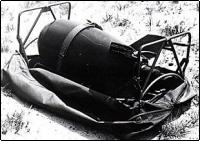 |
|
|
Tactical Rationale
The British Army had planned to deploy the Blue Water missile as a replacement for the obsolete Corporal missile. After Blue Water cancellation, they opted instead for the shorter-range US Honest John missile and 8 inch calibre artillery based on the US M-110. Neither delivery system was able to use a sub-kiloton, or fractional-kiloton warhead, the smallest available being 1 kt. The 2'000 yard minimum safety distance required for a 1 kt warhead fired by artillery or Honest John created a no-man's land of 2'000 yards that could not be covered by nuclear artillery. (10)
Army staff planners believed that an attacking enemy's obvious tactic in that situation would be a rapid advance from a start-line to close the no-man's land gap to 2'000 yards, after which his troops and armour would be immune to nuclear counterattack. The Davy Crockett weapon system with a fractional-yield nuclear warhead and a safety distance of only 600 yards was intended to fill that gap, and provide front line troops with short-response-time nuclear firepower to counter a rapid advance overwhelming frontline troops. Planners believed that the Davy Crockett weapon provided the army with nuclear defence-in-depth, to complement the longer-ranged systems already planned or deployed. Davy Crockett, located with frontline troops had a faster reaction time than artillery, a great advantage over rear-located artillery, that carried with it problems related to poor or broken communications and the established command and control procedures for nuclear weapons. Planners thought that once the shooting started, troops at the front line equipped with this new breed of very low-power nuclear warhead would be less encumbered by command and control techniques designed for high-power weapons one hundred times more powerful at the minimum. (11)
There were other factors too. (12) Army planners believed that light-armoured reconnaissance forces, deep-penetration forces and airborne forces could be largely independent of artillery support. Airborne forces in particular, on arrival, would be given a really lethal punch that they previously lacked because of limitations in the weight of air-dropped artillery.
|
|
Military Characterisics and quantities
Disclosed in a document declassified in 2013 (13) were plans for an alternative warhead for the UK Davy Crockett weapon. Low-Yield Tony, the proposed alternative warhead was most likely to be the Tony warhead stripped of its tritium boosting apparatus. Tony was a British-manufactured copy of the W-44 Tsetse device widely used in American weapons as a stand-alone fission bomb or warhead, and as a primary in several thermonuclear weapons. The engineered design was supplied to Britain under the terms of the 1958 Bilateral Agreement. The Tony warhead would likely have a yield of up to 500 tons, although this might be reduced further by a reduction in fissile material and other measures. However, the basic warhead envelope would retain the physical size characteristics of Tony, which weighed 160 lbs (73 kg). Low-Yield Tony would be a little lighter at 100 lbs (45 kg), making it approximately 45 lbs (20 kg) heavier than Wee Gwen at 55 lb (25 kg). While there may have been some scope for a slight length reduction by removal of the tritium boosting system and various airburst and other fuzing systems, there was no scope for reduction of Low-Yield Tony's diameter, determined as it was by the spherical implosion design that was significantly greater than the W-54-based Wee Gwen.
A physically heavier warhead would likely require a beefed-up launcher, propellant charge, spigot and tripod; growing total weight to much greater values than shown for Wee Gwen.
The principal attraction of the Low-Yield Tony warhead would appear to be the economies of scale possible in production because the Tony warhead was expected to be manufactured as a common weapon in large-scale production for other weapons that included:
- Improved Kiloton Bomb (Red Beard replacement to OR.1176 and OR.1177).
- Bloodhound Mk.3 SAM for the Royal Air Force.
- Seaslug shipborne SAM for the Royal Navy.
- Thunderbird SAM (VR-725) for Army field forces.
- Red Rose 30 mile range SSM for Army field forces.
- Blue Water 70 mile range SSM for Army field forces.
For these weapons a total of 548 Tony warheads were planned and AWRE had in the early 1960s begun acquiring plant and tooling for large scale production. Adding to these a further 1'305 of the low-yield variety offered prospects of considerable economies of scale in production and in spare parts stockholding; a known army requirement, with same-type spares being available for the army's SAMs, SSMs and Davy Crockett.
Tony was an anglicised copy of the US W-44 Tseste warhead, made available to the UK after the 1958 US–UK Mutual Defence Agreement (usually referred to as the 1958 Bilateral). Ocassionally found in declassified archives are references to Low-Yield Gwen, thought to be a reference to Wee Gwen. It was not unusual in Whitehall documents of the time to encounter more than one name for the same object or weapon, especially in the very early stages of the specification and procurement process.
Where there is known size and weight data for Low-Yield Tony this is added to the table below in red font.
|
|
Wee Gwen |
Low-Yield Tony |
Diameter |
10.75 in |
|
Length |
17.6 in |
|
Weight |
50-55 lbs dependent on yield |
|
Yield min |
|
|
Yield max |
|
|
Range |
2'000 yards (1'830 m) (light launcher) |
Range |
4'000 yards (3'660 m) (heavy launcher) |
Min safety range |
600 yards (550 m) |
CEP |
30 yards (22.5 m) @ 2'000 yards (1'830 m) |
CEP |
60 yards (55.0 m) @ 4'000 yards (3'660 m) |
|
1'275 |
|
Fissile material: Pu-239 |
|
|
Fissile material: U-235 |
|
|
Launchers required |
600 |
|
|
|
55 lbs (25 kg) |
100 lb (45 kg)
|
2: launcher & sighting rifle |
58 lbs (26.3 kg) |
unknown |
3: spigot & tripod |
57 lbs (25.9 kg) |
unknown |
Total weight |
170 lbs (77.3 kg) |
c. 220 lb (100 kg) min |
Studies showed that in order to detonate these nuclear weapons safely, but close to friendly front-line troops, the best choice of yield was 10-20 tons. A greater yield was not especially useful, since the killing power of the weapon used against advancing enemy troops in armoured vehicles and in the open was greater by neutron and gamma emission than by the more conventional effects of heat and blast. (31) Armoured troops in particular were mostly unaffected by blast on the scale of this weapon, but armour provides little protection from radiation emissions of Wee Gwen, casualties would be unlikely to survive longer than 36 hours. Enemy troops in the open at up to 70 yards (64m) would have loss of co-ordination within one minute, be incapacitated, and death would follow within 36 hours. A 10 ton yield warhead could be detonated as close as 600 yards (550m) to friendly troops.
|
|
Deployment
Neither Wee Gwen nor its launcher, Davy Crockett were deployed with the British Army. (32) The project never proceeded far, the principal reasons being internal Service strife and disagreements within the Army, and the critical shortage of fissile material. The weight of the fissile core is now known, (33) and the total amount of plutonium required for the full programme of 1'275 warheads amounts to a total of 2'040 kg, plus a quantity of 3'086 kg of U-235. That amount was never a possibility for the UK given the scarity and the high cost. However other declassified documents put a higher figure on the Army's total requirements at 1'305 warheads. It also discloses that "Low Yield Tony" an alternative warhead to the W-54 Wee Gnat was being considered and actively planned for production until at least 1961. (34) Furthermore, another recent declassification discloses that there was yet another warhead being considered. This warhead was known as Queenie and almost nothing is known of it other than it was sponsored by the Army for use with a "sub kiloton mortar". (35) That can only refer to Davy Crockett.
There were strong disagreements within the Army about the usefulness of the weapon. The Army Council believed that the weapon was
- a high-priority tactical requirement for our small army.
- That it could provide airborne and similar light forces with a heavy punch, where artillery was not available.
The artillery establishment (36) believed that the weapon:
- Threatened artillery control of battlefield bombardment.
- Considered Davy Crockett to be a poor weapon, that was fundamentally unsound.
- It created difficulties of command and control.
- It was inferior to nuclear artillery.
- It was wasteful of scarce fissile material.
The artillery establishment view prevailed, and the weapon and warhead project was cancelled.
|
Footnotes

- back TNA WO 32/17073 E80a. United States nuclear weapon `Davy Crockett' : tactical aspects. 1958-1962.
- back TNA AVIA 65/1050 E87a p2. A fractional yield nuclear weapon. 1959-1962.
- back Chuck Hansen. Swords of Armageddon. V1.0 vol 7 p41 p114. Chukelea Publications, Sunnyvale, CA. 1995.
- back TNA AVIA 65/1050 E70. A fractional yield nuclear weapon. 1959-1962.
- back nuclearweaponarchive.org W-54
- back Chuck Hansen. Swords of Armageddon. V1.0 vol 7 p476-7. Chukelea Publications, Sunnyvale, CA. 1995.
(2) Roger L.Albertson. Soldier of Fortune. Vol 20 No5 1995 p45, Backpack nukes for Nam.
- back TNA AB 16/4675 p63. UKAEA Weapons Department Atomic Warheads Production Cttee, Papers & Minutes. 1964.
- back TNA AVIA 65/1050 E25a A fractional yield nuclear weapon. 1959-1962.
- back TNA AVIA 65/1047 E55 p1-3 Atomic weapons policy: ADMs. 1957-1963.
- back TNA AVIA 65/1050 E2 p3 A fractional yield nuclear weapon. 1959-1962.
- back TNA AVIA 65/1050 E98 p2-3. A fractional yield nuclear weapon. 1959-1962.
- back TNA AVIA 65/1050 E2 p4-5 A fractional yield nuclear weapon. 1959-1962.
- back TNA AVIA 65/2090 E3 p2 Ministry of Aviation Atomic Warheads Production Cttee: agendas, papers & minutes. 1960-63.
back TNA AVIA 65/2090 E5 p2 Ministry of Aviation Atomic Warheads Production Cttee: agendas, papers & minutes. 1960-63.
back TNA AVIA 65/2090 E11 p2 Ministry of Aviation Atomic Warheads Production Cttee: agendas, papers & minutes. 1960-63.
- back TNA AVIA 65/1862 E16 p23-24, col G. ASR 1176 and 1177: nuclear weapon requirement. 1959-63.
- back TNA AVIA 65/1862 E16 p23-24, col G. ASR 1176 and 1177: nuclear weapon requirement. 1959-63.
- back TNA AB 16/3240 A1164 p2 UKAEA Atomic Warheads Production Cttee: general correspondence. 1958-66.
- back TNA AB 16/4675 UKAEA Atomic Warheads Production Cttee. 1959-65.
back TNA AVIA 65/1047 E55 p1-3 Ministry of Aviation Atomic Weapons policy: ADMs. 1957-1963.
- back TNA AB 16/3240 A1164 p2 UKAEA Atomic Warheads Production Cttee: general correspondence. 1958-66.
- back TNA AB 16/3240 A1164 p2 UKAEA Atomic Warheads Production Cttee: general correspondence. 1958-66.
- back TNA AB 16/3240 A1164 p2 UKAEA Atomic Warheads Production Cttee: general correspondence. 1958-66.
- back TNA AVIA 65-1050 E8 annex p2. A fractional yield nuclear weapon. 1959-1962.
- back TNA AVIA 65/2090 E3 p2 Ministry of Aviation Atomic Warheads Production Cttee: agendas, papers & minutes. 1960-63.
back TNA AVIA 65/2090 E5 p2 Ministry of Aviation Atomic Warheads Production Cttee: agendas, papers & minutes. 1960-63.
back TNA AVIA 65/2090 E11 p2 Ministry of Aviation Atomic Warheads Production Cttee: agendas, papers & minutes. 1960-63.
- back TNA AB 16/4675 p63. UKAEA Weapons Department Atomic Warheads Production Cttee, Papers & Minutes. 1964.
- back TNA AB 16/4675 p63. UKAEA Weapons Department Atomic Warheads Production Cttee, Papers & Minutes. 1964.
- back TNA AB 16/4675 p63. UKAEA Weapons Department Atomic Warheads Production Cttee, Papers & Minutes. 1964.
- back TNA AB 16/4675 p63. UKAEA Weapons Department Atomic Warheads Production Cttee, Papers & Minutes. 1964.
- back TNA WO 32/17073 E3b. United States nuclear weapon `Davy Crockett' : tactical aspects. 1958-1962.
- back TNA AVIA 65/1050 E87a. A fractional yield nuclear weapon. 1959-1962.
- back TNA AVIA 65/2090 E3 p2 Ministry of Aviation Atomic Warheads Production Cttee: agendas, papers & minutes. 1960-63.
back TNA AVIA 65/2090 E5 p2 Ministry of Aviation Atomic Warheads Production Cttee: agendas, papers & minutes. 1960-63.
back TNA AVIA 65/2090 E11 p2 Ministry of Aviation Atomic Warheads Production Cttee: agendas, papers & minutes. 1960-63.
- back TNA AVIA 65/1050 E81c p2-3. A fractional yield nuclear weapon. 1959-1962.
- back TNA AVIA 65/1050 E81c p2-3. A fractional yield nuclear weapon. 1959-1962.
back TNA WO 32-17073 E78a. United States nuclear weapon Davy Crockett: tactical aspects.1958-1962.
- back TNA WO 32/19928 E14a p3. Davy Crockett Battle Group Weapon System: War Office proposals. 1960-1962.
- back TNA AB 16/4675 p63. UKAEA Weapons Department Atomic Warheads Production Cttee, Papers & Minutes. 1964.
- back TNA AVIA 65/2090 E3 p2 Ministry of Aviation Atomic Warheads Production Cttee: agendas, papers & minutes. 1960-63.
back TNA AVIA 65/2090 E5 p2 Ministry of Aviation Atomic Warheads Production Cttee: agendas, papers & minutes. 1960-63.
back TNA AVIA 65/2090 E11 p2 Ministry of Aviation Atomic Warheads Production Cttee: agendas, papers & minutes. 1960-63.
- back TNA AB 16/4675 p62. UKAEA Weapons Department Atomic Warheads Production Cttee, Papers & Minutes. 1964.
- back TNA WO 32/19928 E17a. Davy Crockett Battle Group Weapon System: War Office proposals. 1960-1962.
back TNA WO 32/19928 E20a. Davy Crockett Battle Group Weapon System: War Office proposals. 1960-1962.
back TNA WO 32/19928 E22a p2 Davy Crockett Battle Group Weapon System: War Office proposals. 1960-1962.
|
Dazzle
Under construction.
|

|
Depth Bomb
Under construction.
|

|
Diablo Hawk
Under construction.
|

|
Diamond Skulls
Under construction.
|

|
Dicel
Under construction.
|

|
Dick
Under construction.
|

|
Dido Queen
Under construction.
|

|
Dingbat
Under construction.
|

|
Ding Dong
Under construction.
|

|
Dining Car
Under construction.
|

|
Disposable Bomber
|

|
|
Description
Disposable Bomber was a British archaic term, used immediately post-WW2 and used predominately by the Royal Air Force and Air Ministry to describe a one-way trip missile, now usually referred to as a cruise missile. The term described an air-breathing vehicle that was unmanned, and did not return to its start point. During WW2 the only vehicle of this type used in combat was the German V1 pilotless aircraft. Another term, used interchangably, was Expendable Bomber.
The British and the Americans were attracted to the V1 concept because it appeared to offer considerable savings in the costs of strategic bombing, either armed with conventional HE warheads or atomic warheads. The savings were believed to be derived from large reductions in aircrew training, especially since WW2 experience showed attrition rates of aircrew were considerable and costly. The pilotless aircraft themselves were believed to be inexpensive, quick and easy to manufacture; yet smaller than conventional piloted bombers. Being smaller, they consumed fewer resources in manufacture, and used less fuel for any given combat range because they made no return trip. Their limited-lifespan turbojet engines were simple and cheap to manufacture and service, especially when compared to the multiple and complex piston engines of wartime manned bombers, and they used low-grade fuel.
The downsides though were considerable in the 1945-50 period. Aeronautical technology available in the postwar period was adequate, especially with the advances made in jet engines, but guidance was the weak link. Inertial autopilots were generally of a poor quality and precise target locations (especially in the USSR) were an almost complete unknown. To be of real use, Disposable Bombers, Expendable Bombers, Cruise Missiles, needed the great advances of satellite reconnaissance, mapping, and computing technology.
The British produced a couple of prototype pilotless bombers ot specification OR.1097, Red Rapier a turbojet-powered aircraft modeled on the V1 concept manufactured cheaply in steel by Vickers-Armstrong, and Blue Rapier a more elaborate concept, designed by Bristol Aircraft as both a bomber and a decoy. As a decoy, it was envisaged as accompanying formations of manned V-bombers, so as to apparently swell the numbers in the formation and give the manned bombers some additional security in numbers. Neither of these got beyond prototype stage, and it is doubtfull if any actually flew.
The Americans with their greater resources of funds were more adventurous. The Regulus submarine-carried missile entered service with the US Navy in the pre-Polaris era. Submarines could carry up to five,
(1)
and to launch Regulus, the vessel had to surface and assemble the weapon on-deck. The US Air Force experimented with larger, longer-ranged weapons such as Snark, one of which is alleged to have veered off-course so badly as to find a landing spot deep in the Brazilian rainforest. As stated above, the weak link was navigation and guidance.
|
Footnotes
- back
Ed Lilly Personal email from a former Regulus submarine crewman.
|
Double Bomb
Under construction.
|

|
Dutchess
Under construction.
|

|
Earth Shock Bomb
Under construction.
|

|
Economy Tests
Under construction.
|

|
EE.18
Under construction.
|

|
Eligible
Under construction.
|

|
Emergency Capability Weapon
Under construction.
|

|
ENI (External Neutron Initiator)
Under construction.
|

|
Ensign
Under construction.
|

|
Erosion Head
|

|
|
Description
Erosion Head was an archaic British term used in the 1950-60 period to describe a ballistic missile Re-entry Vehicle ( RV) or Re-Entry Body ( ReB).
Used mainly in the period when the Blue Streak MRBM project was in progress along with it's associated development and test missiles, the term fell from use after these wholly British weapons were cancelled. When, in the early 1960s the UK decided to purchase the Polaris SLBM British nomenclature began to fall into step with American terms. ReB as used by the US Navy became the common standard in British usage, and the term Erosion Head fell into disuse.
|
|
ET.317
Under construction.
|

|
Expendable Bomber
|

|
|
Description
Expendable bomber was a British archaic term, used immediately post-WW2 and used predominately by the Royal Air Force and Air Ministry to describe a one-way trip missile, now usually referred to as a cruise missile. The term described an air-breathing vehicle that was unmanned, and did not return to its start point. During WW2 the only vehicle of this type used in combat was the German V1 pilotless aircraft. Another term, used interchangably, was Disposable Bomber.
The British and the Americans were attracted to the V1 concept because it appeared to offer considerable savings in the costs of strategic bombing, either armed with conventional HE warheads or atomic warheads. The savings were believed to be derived from large reductions in aircrew training, especially since WW2 experience showed attrition rates of aircrew were considerable and costly. The pilotless aircraft themselves were belived to be inexpensive, quick and easy to manufacture; yet smaller than conventional piloted bombers. Being smaller, they consumed fewer resources in manufacture, and used less fuel for any given combat range because they made no return trip. Their limited-lifespan turbojet engines were simple and cheap to manufacture and service, especially when compared to the multiple and complex piston engines of wartime manned bombers, and they used low-grade fuel.
The downsides though were considerable in the 1945-50 period. Aeronautical technology available in the postwar period was adequate, especially with the advances made in jet engines, but guidance was the weak link. Inertial autopilots were generally of a poor quality and precise target locations (especially in the USSR) were an almost complete unknown. To be of real use, Expendable Bombers, Disposable Bombers, Cruise Missiles, needed the great advances of satellite reconnaissance, mapping, and computing technology.
The British produced a couple of prototype pilotless bombers ot specification OR.1097, Red Rapier a turbojet-powered aircraft modeled on the V1 concept manufactured cheaply in steel by Vickers-Armstrong, and Blue Rapier a more elaborate concept, designed by Bristol Aircraft as both a bomber and a decoy. As a decoy, it was envisaged as accompanying formations of manned V-bombers, so as to apparently swell the numbers in the formation and give the manned bombers some additional security in numbers. Neither of these got beyond prototype stage, and it is doubtfull if any actually flew.
The Americans with their greater resources of funds were more adventurous. The Regulus submarine-carried missile entered service with the US Navy in the pre-Polaris era. Submarines could carry up to five,
(1)
and to launch Regulus, the vessel had to surface and assemble the weapon on-deck. The US Air Force experimented with larger, longer-ranged weapons such as Snark, one of which is alleged to have veered off-course so badly as to find a landing spot deep in the Brazilian rainforest. As stated above, the weak link was navigation and guidance.
|
Footnotes
- back
Ed Lilly Personal email from a former Regulus submarine crewman.
|
|








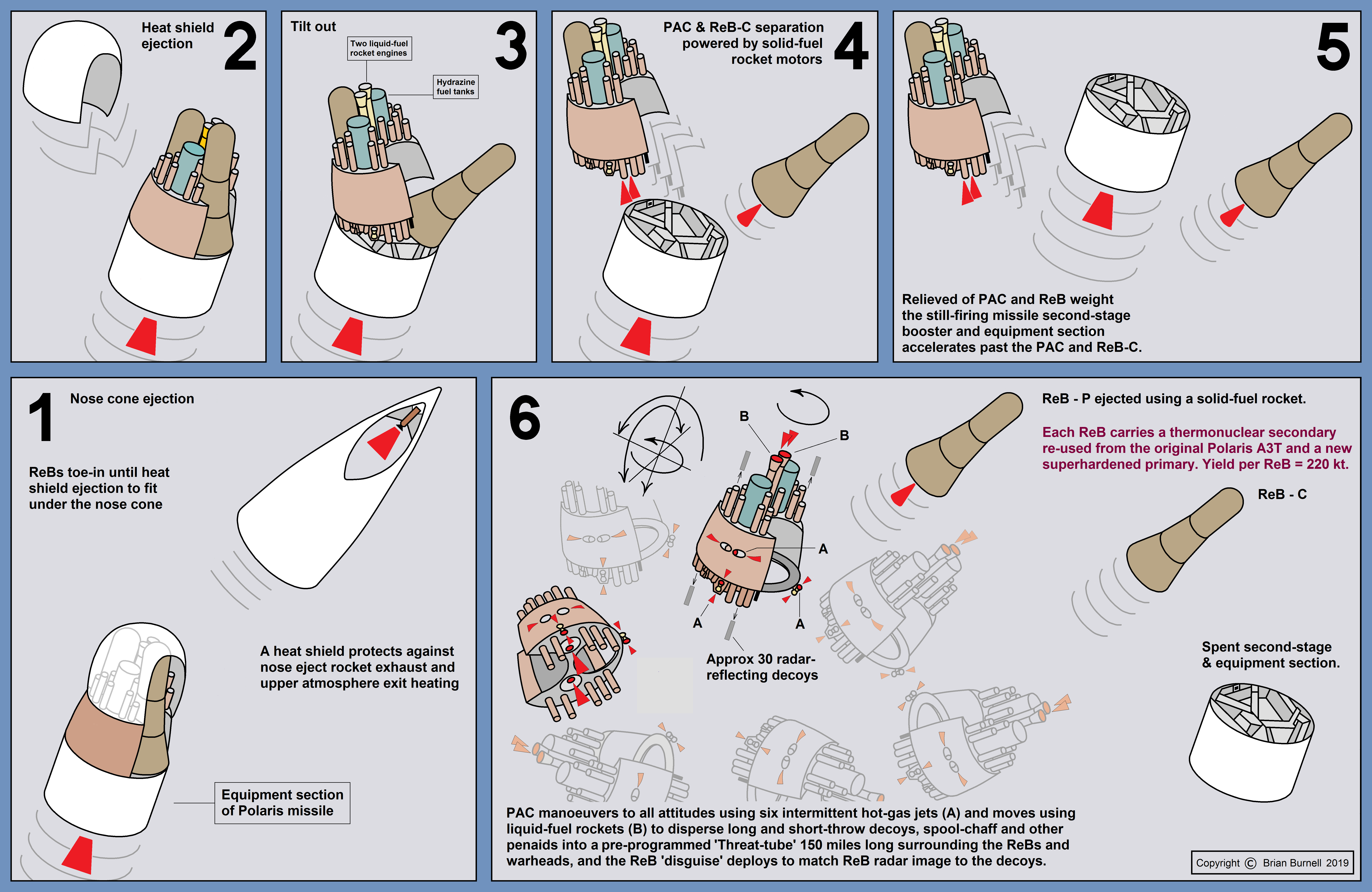














































 Source: US Army.
Source: US Army.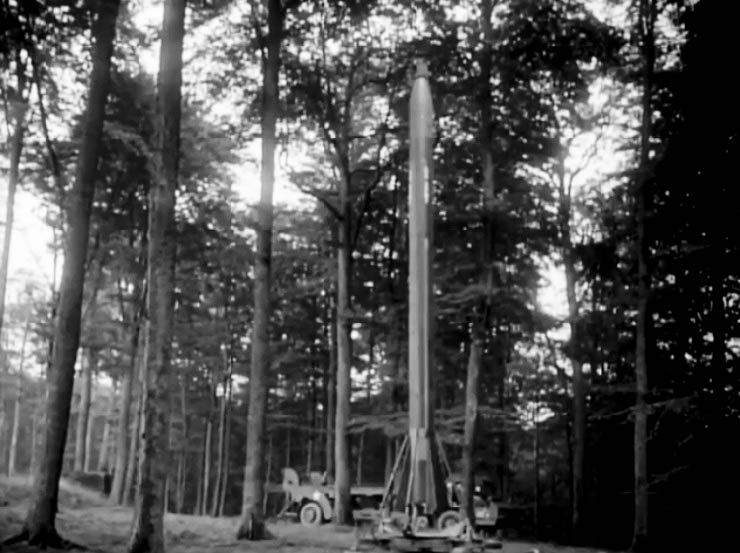 Corporal erected and ready to fire while hidden in a forest clearing.
Corporal erected and ready to fire while hidden in a forest clearing.

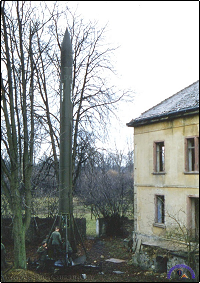 Hidden in a residential backyard near Mainz.
Hidden in a residential backyard near Mainz. Located on heavily sloped property, circa late 1950s.
Located on heavily sloped property, circa late 1950s. Nose section for the W-7 warhead.
Nose section for the W-7 warhead. Mating a W-7 warhead to Corporal on field exercise.
Mating a W-7 warhead to Corporal on field exercise. Opening the nose cone of the W-7.
Opening the nose cone of the W-7. Nose cone opened exposing fuze.
Nose cone opened exposing fuze. Minimum and max time fuze setting.
Minimum and max time fuze setting.

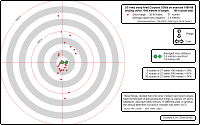
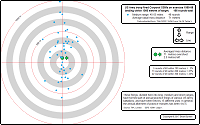
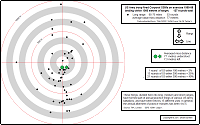
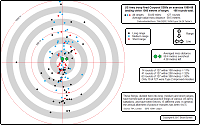
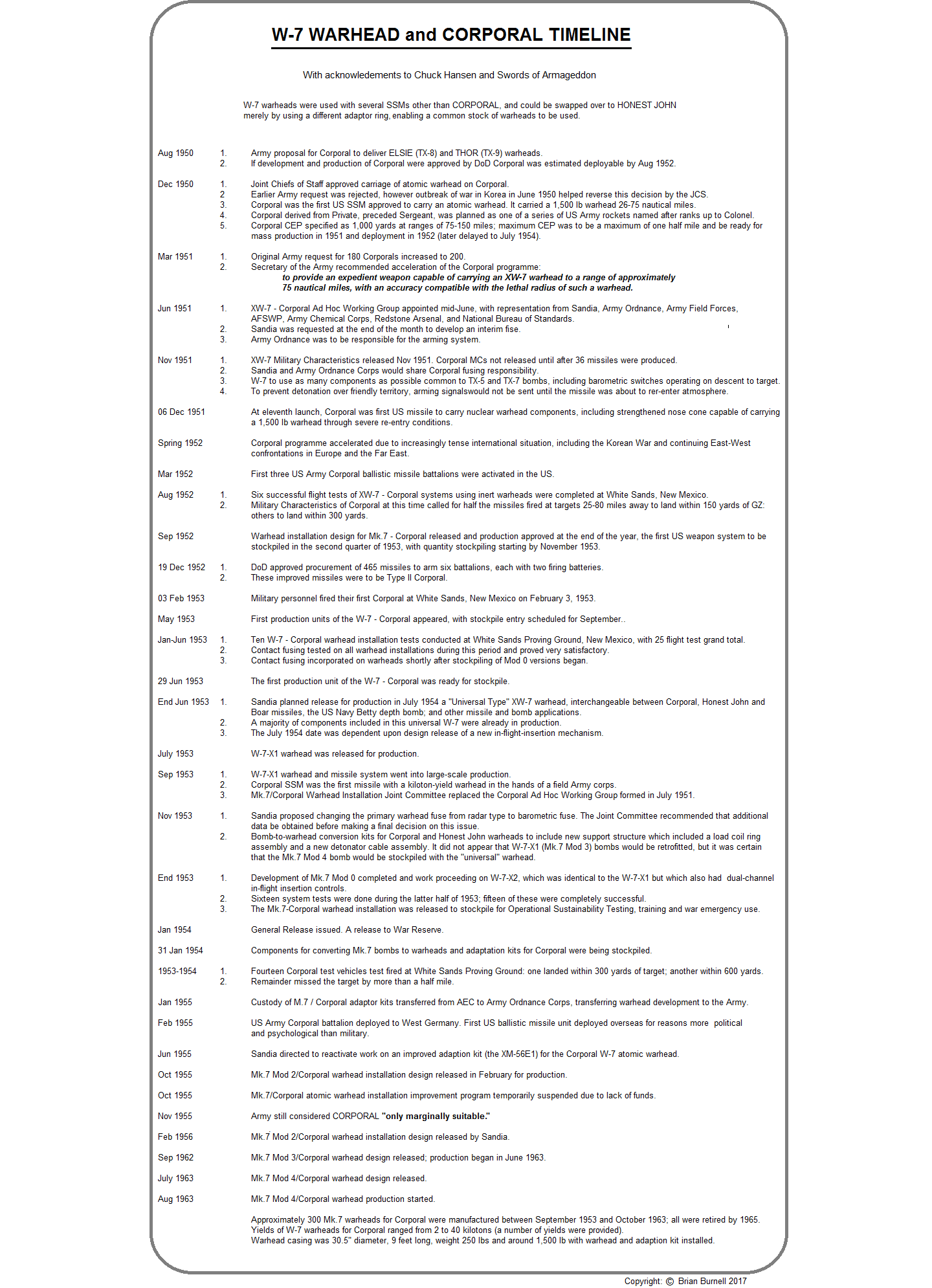


















































































































































































































































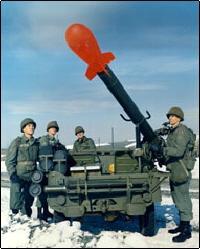
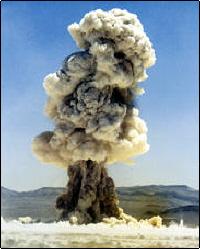
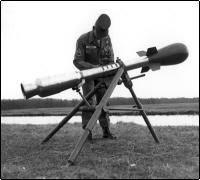

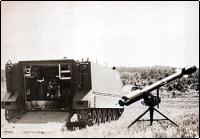
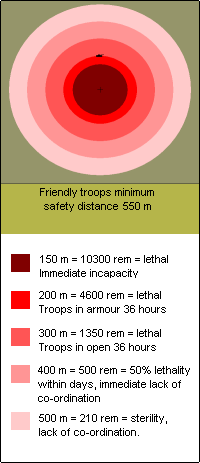




























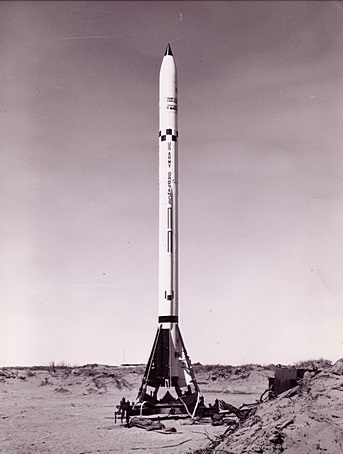 Source: US Army.
Source: US Army. Corporal hidden in a forest clearing.
Corporal hidden in a forest clearing. Acid and aniline flasks.
Acid and aniline flasks.
 Acid truck.
Acid truck.
 Aniline truck.
Aniline truck.
 British Army propellant loading drill. Source: TNA WO 279/249 p69.
British Army propellant loading drill. Source: TNA WO 279/249 p69.

 Manual Last-Minute-Loading of a nuclear core (codenamed Gauntlet) in an aircraft bomb, believed to be Red Beard. A difficult task on a rain swept and windswept aircraft carrier deck in the North Atlantic.
Manual Last-Minute-Loading of a nuclear core (codenamed Gauntlet) in an aircraft bomb, believed to be Red Beard. A difficult task on a rain swept and windswept aircraft carrier deck in the North Atlantic. Nose section for the W-7 warhead and its transportation container.
Nose section for the W-7 warhead and its transportation container. Lifting a W-7 warhead from plywood transportation crate.
Lifting a W-7 warhead from plywood transportation crate. Assembling the W-7 warhead to the missile.
Assembling the W-7 warhead to the missile.
